FAQ - Advanced Bathroom Queries
How Do You Flush a Touchless Toilet
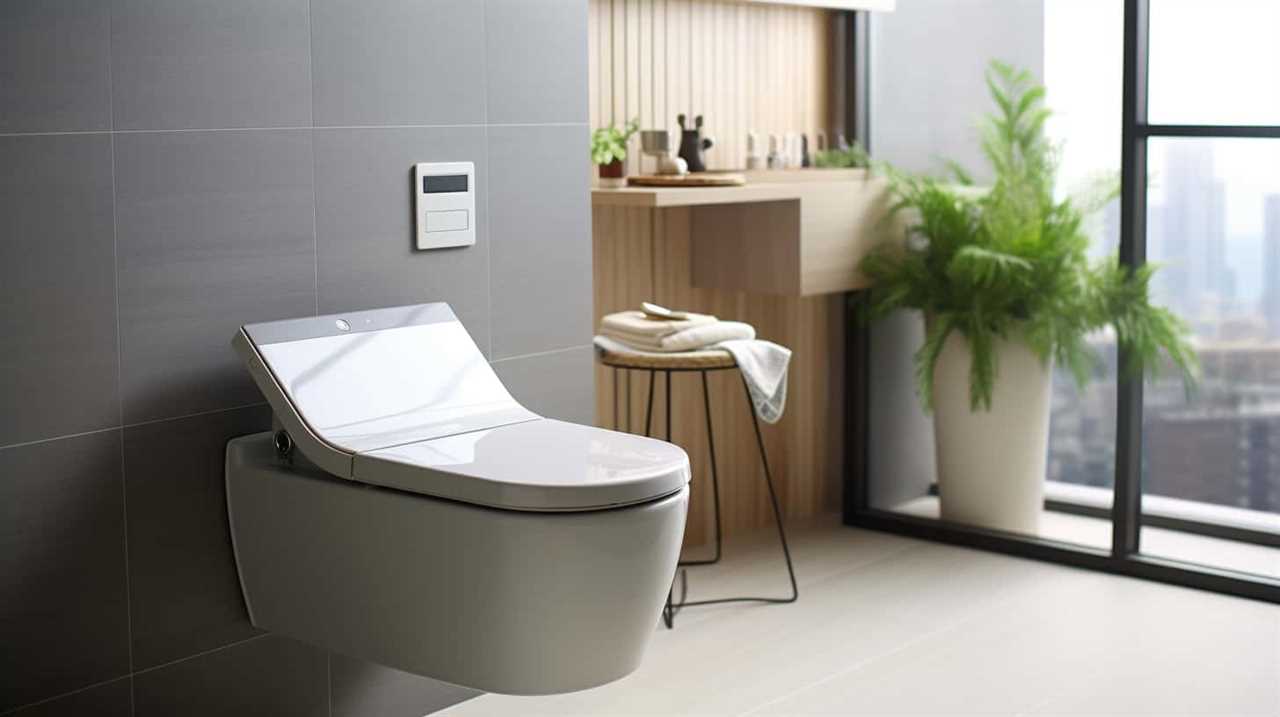
Everyone has come across hands-free toilets in public bathrooms, but have you considered the mechanics behind their operation? This piece will explore the intriguing technology that powers touchless flushing and reveal how the flush sensor is triggered.
We’ll also explore the benefits of touchless toilets and compare them to traditional ones. Whether you’re considering installing a touchless toilet in your bathroom or simply curious about this innovative system, we’ve got you covered with all the information you need.
Key Takeaways
- Touchless toilets utilize a motion sensor to automatically flush when a person is near.
- They reduce the risk of spreading germs and bacteria by eliminating the need to touch handles or buttons.
- Touchless flushing conserves water by accurately detecting user presence and only activating when necessary.
- Proper sensor placement, sensitivity adjustment, and regular cleaning and maintenance are important for optimal functionality.
Understanding Touchless Toilets
We have found that touchless toilets utilize a motion sensor to detect when a person is near and automatically flushes, eliminating the need for physical contact with the flush handle. This sensor installation is a crucial component of touchless toilet features. The sensor is typically located on the top or front of the toilet, and it works by emitting infrared light that reflects off objects in its range. When someone approaches the toilet, the sensor detects the reflected light and sends a signal to the flushing mechanism, triggering the flush.
One of the key advantages of touchless toilets is their hygienic nature. By eliminating the need to touch the flush handle, they help reduce the risk of spreading germs and bacteria. Additionally, touchless toilets are user-friendly and convenient, as they automatically flush without any effort from the user.

To install a touchless toilet sensor, you’ll typically need to follow the manufacturer’s instructions. The sensor often comes with adhesive backing or mounting brackets for easy installation on the toilet tank or wall. Some touchless toilets also come with adjustable sensor settings, allowing users to customize the sensor’s sensitivity and range.
With a solid understanding of touchless toilet features and sensor installation, let’s delve into the technology behind touchless flushing.
The Technology Behind Touchless Flushing
When it comes to touchless flushing, the technology behind it’s quite fascinating. The sensor-based flushing mechanism is at the heart of this innovation, allowing the toilet to detect when to flush without any physical contact.
This not only provides a hygienic solution for users but also contributes to energy efficiency by only using water when needed.
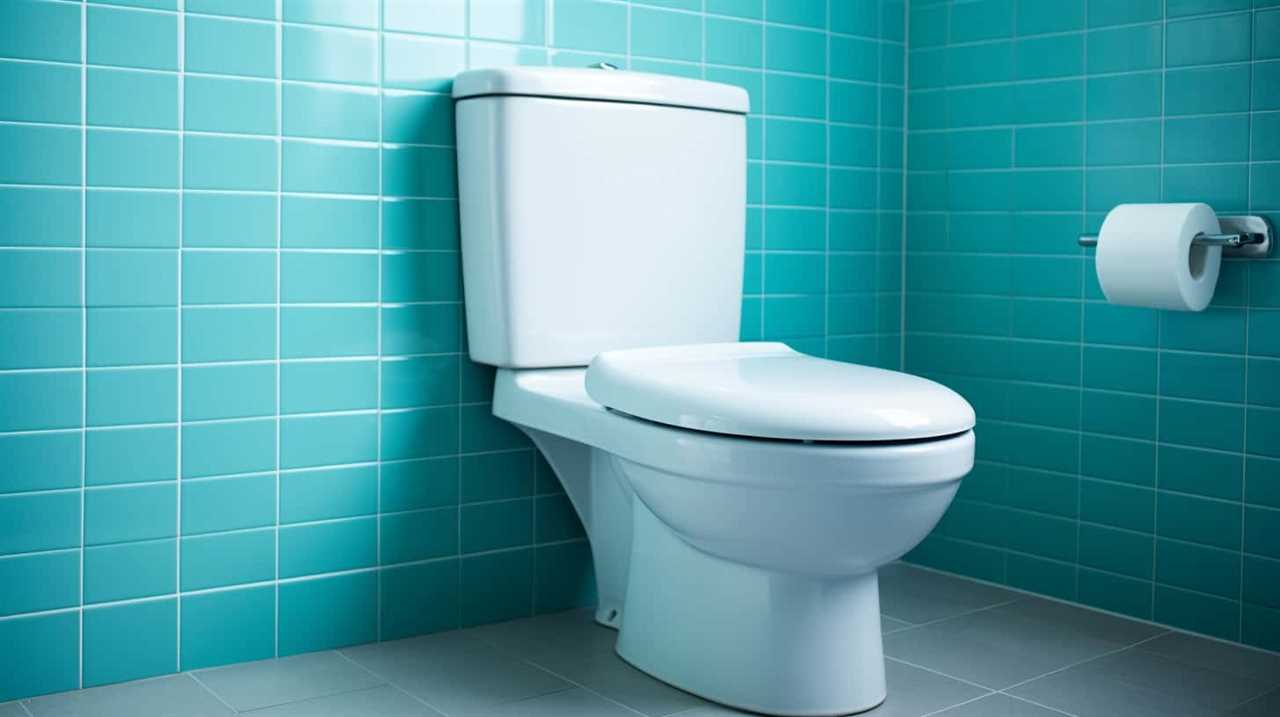
Sensor-Based Flushing Mechanism
Using a sensor-based flushing mechanism is a convenient and hygienic way to activate the flush of a touchless toilet. The sensor detects the presence of a user and triggers the flushing mechanism automatically, eliminating the need for physical contact.
This technology offers several benefits. Firstly, it promotes improved hygiene by minimizing the transfer of germs and bacteria. Users don’t need to touch any buttons or handles, reducing the risk of cross-contamination.
Secondly, sensor-based flushing mechanisms require less maintenance compared to traditional toilets. Since there are no buttons or handles to be touched, there’s less wear and tear.
However, it’s important to ensure regular sensor maintenance to ensure proper functionality. Cleaning the sensor periodically with a soft cloth and non-abrasive cleaner can help maintain its accuracy and effectiveness.
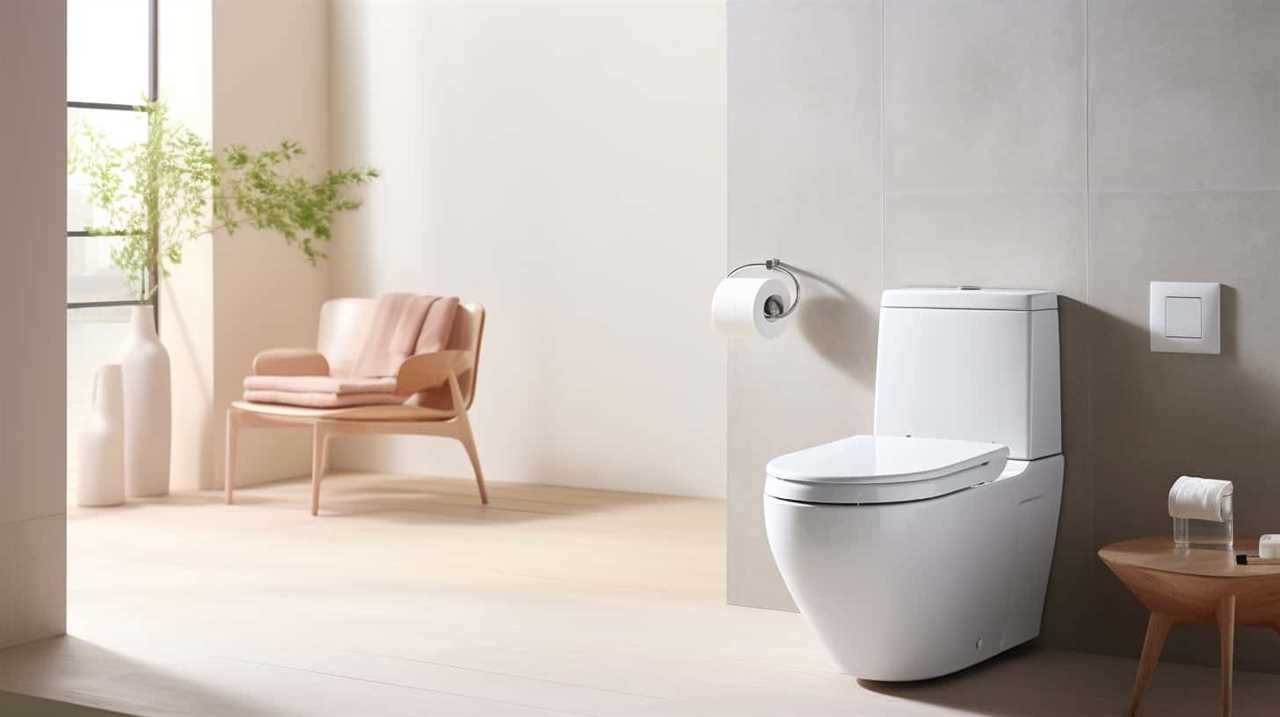
Hygienic Benefits of Touchless Toilets
Touchless toilets offer numerous hygienic benefits due to their innovative flushing technology. Here are three reasons why touchless toilets are a hygienic option for your bathroom:
- Reduced contact with germs: With touchless toilets, you don’t need to touch any handles or buttons, which means you minimize the risk of coming into contact with germs and bacteria that may be present on these surfaces.
- Automatic flushing: Touchless toilets have sensors that detect when you’re finished using the toilet and automatically flushes without the need for manual intervention. This eliminates the need to touch the flush handle, further reducing the spread of germs.
- Easy to clean: Touchless toilets are designed to be easy to clean and maintain. With fewer crevices and no flush handles or buttons, cleaning becomes simpler, reducing the chances of dirt and bacteria buildup.
In order to fully enjoy these hygienic benefits, proper touchless toilet installation and routine maintenance are essential.
Transitioning from the hygienic benefits, let’s now explore the energy efficiency of touchless flushing.
Energy Efficiency of Touchless Flushing
As we explore the energy efficiency of touchless flushing, it is important to understand the technology behind this innovative system. Touchless flushing toilets are equipped with sensors that accurately detect the presence of a user and trigger the flushing mechanism. These sensors use infrared technology to detect the heat emitted by a person’s body. Once the user moves away from the toilet, the sensor sends a signal to the flushing mechanism, which then activates to flush the waste away. This technology not only provides a hygienic and convenient experience, but also contributes to water conservation. By accurately detecting the user’s presence, touchless flushing toilets eliminate the need for manual flushing, reducing the risk of accidental flushes and conserving water.
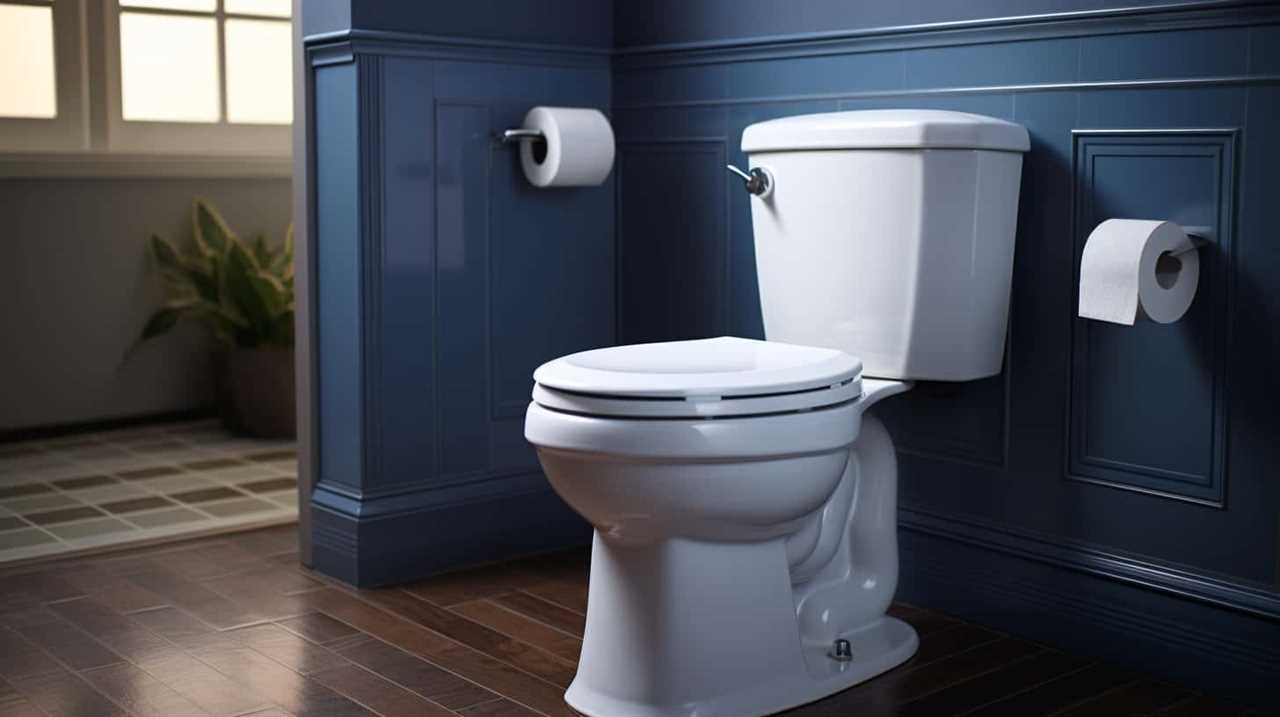
| Advantages of Touchless Flushing | Sensor Accuracy | Water Conservation |
|---|---|---|
| Hygienic | Sensors accurately detect the user and trigger the flushing mechanism. | Eliminates the need for manual flushing, reducing water usage. |
| Convenient | Users can flush without touching any surfaces, reducing the risk of cross-contamination. | Reduces accidental flushes, conserving water in the process. |
| Efficient | The flushing mechanism activates only when necessary, saving water. | Contributes to water conservation efforts by reducing overall water consumption. |
Locating the Flush Sensor
Now let’s talk about the important task of locating the flush sensor on a touchless toilet.
Proper sensor placement is crucial for the toilet to function effectively.
We’ll provide some tips on where to position the sensor and how to troubleshoot any sensor-related issues that may arise.
Sensor Placement Tips
To locate the flush sensor on a touchless toilet, we need to consider the placement of the sensor. Proper sensor placement is crucial for maximizing the performance and efficiency of the touchless toilet system. Here are three important tips to optimize sensor performance:

- Position the sensor at an optimal height: Mount the sensor at a height that ensures it can detect hand movements easily, without the need for excessive arm movements. Generally, a height of 20 to 25 inches from the floor is recommended.
- Avoid direct sunlight or bright lights: Placing the sensor in direct sunlight or near bright lights can interfere with its ability to accurately detect hand movements. Ensure the sensor is installed in an area with adequate lighting, but away from direct light sources.
- Avoid obstacles and reflections: Place the sensor away from any obstacles or reflective surfaces that may interfere with its detection capabilities. This includes mirrors, shiny tiles, or nearby objects that could cause false readings.
Troubleshooting Sensor Issues
After considering the placement tips for optimizing sensor performance, we can now troubleshoot any issues related to locating the flush sensor on a touchless toilet. One common problem could be sensor calibration. If the flush sensor is not properly calibrated, it may not detect your hand movement accurately, leading to inconsistent flushing. To address this, refer to the manufacturer’s instructions to recalibrate the sensor or contact their customer support for assistance.
Another potential issue could be related to water pressure. If the water pressure is too low, the sensor may struggle to detect your hand movement and initiate the flushing mechanism. Conversely, if the water pressure is too high, it could trigger false flushes or cause the sensor to malfunction. Check the water pressure in your plumbing system and adjust it accordingly to ensure optimal sensor performance.
Below is a table summarizing the troubleshooting steps for locating the flush sensor:
| Issue | Possible Solution |
|---|---|
| Sensor Calibration | Refer to manufacturer’s instructions for recalibration |
| Contact customer support for assistance if needed | |
| Troubleshooting Water Pressure | Check water pressure in plumbing system |
| Adjust water pressure to ensure optimal sensor performance |
How to Activate the Flush Sensor
To activate the flush sensor, we simply wave our hand in front of it. The flush sensor is designed to detect motion and initiate the flushing process.
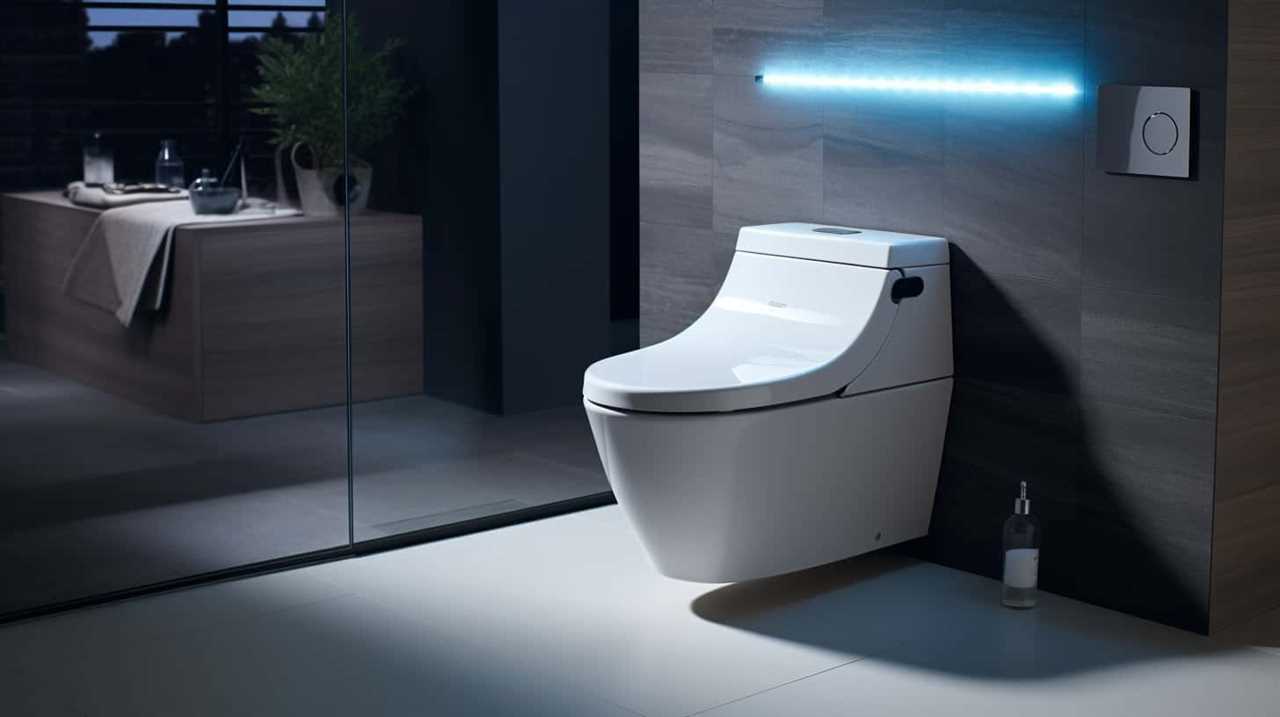
Here are three important things to know about activating the flush sensor:
- Proper hand placement: Ensure that your hand is within the sensor’s range, typically indicated by a marked area on the toilet or sensor itself. Position your hand about 2-3 inches away from the sensor for optimal detection.
- Gesture recognition: The flush sensor is programmed to recognize specific hand gestures, such as a wave or swipe. Make sure to perform the recognized gesture consistently and clearly in front of the sensor to activate the flush.
- Sensor sensitivity: In some cases, the flush sensor’s sensitivity may need to be adjusted. If you find that the sensor isn’t detecting your hand motion, consult the toilet’s user manual for instructions on adjusting the sensor sensitivity. This can usually be done by accessing the control panel or settings on the toilet.
Adjusting the Sensor Sensitivity
Now let’s delve into how we can adjust the sensor sensitivity on our touchless toilet. Adjusting the sensitivity levels of the sensor is crucial for ensuring optimal performance and avoiding any sensitivity issues. If the sensor is too sensitive, it may activate the flush even when you aren’t intending to use it. On the other hand, if the sensor isn’t sensitive enough, it may fail to detect your presence and the flush won’t be activated.
To adjust the sensor sensitivity, locate the adjustment dial or button on the control panel of your touchless toilet. This dial or button allows you to increase or decrease the sensitivity levels. Start by setting the sensor to its default sensitivity level, if available. If you’re experiencing sensitivity issues, try adjusting the sensitivity level gradually, making small changes at a time. Test the flush after each adjustment to determine if the sensitivity is now at an optimal level.
If you’re still facing sensitivity issues after adjusting the sensitivity levels, there may be other factors causing the problem. Ensure that the sensor is clean and free from any dirt or debris that could be obstructing its functionality. Additionally, check for any obstructions in the toilet area that may be interfering with the sensor’s detection capabilities.

Proper Hand Placement for Flushing
To ensure a successful flush, we need to place our hands correctly on the touchless toilet’s sensor. Proper hand placement is essential for activating the flushing mechanism and making the most of the touchless technology. Here are three key points to consider:
- Position your hands within the sensor range: The touchless toilet’s sensor is designed to detect motion within a specific range. To activate the flushing mechanism, place your hands within this range, usually indicated by a marked area on the sensor. Keep your hands steady and avoid abrupt movements to ensure accurate detection.
- Maintain a consistent distance: Consistency is key when it comes to hand placement. Keep your hands at a consistent distance from the sensor throughout the flushing process. This helps maintain a steady connection with the touchless technology and ensures a reliable flush every time.
- Avoid covering the sensor: Ensure that your hands don’t obstruct or cover the sensor. Obstructions can interfere with the touchless technology’s ability to detect motion and may result in an unsuccessful flush. Keep your hands slightly elevated above the sensor, allowing for unobstructed detection.
The Importance of a Clean Sensor
As we continue to explore the proper hand placement for flushing a touchless toilet, it’s crucial to emphasize the importance of keeping the sensor clean. Maintaining a clean sensor is essential for the optimal performance of the touchless toilet system. The sensor is responsible for detecting movement and triggering the flush mechanism, so any dirt or debris on the sensor can interfere with its functionality. To ensure a clean sensor, it’s recommended to use appropriate cleaning techniques and regularly perform sensor maintenance.
When it comes to cleaning the sensor, it’s important to use gentle cleaning methods to avoid damaging the sensitive components. Start by using a soft cloth or sponge dampened with a mild cleaning solution to wipe the surface of the sensor. Avoid using abrasive or harsh chemicals, as they can damage the sensor. Pay special attention to the area around the sensor, as dirt or grime buildup can impede its effectiveness.
In addition to regular cleaning, sensor maintenance is also crucial. Check the sensor periodically for any signs of wear or damage. If you notice any issues, such as a slow or unresponsive flush, it may be necessary to replace the sensor or contact a professional for assistance. By implementing these cleaning techniques and performing regular sensor maintenance, you can ensure the optimal performance of your touchless toilet system.
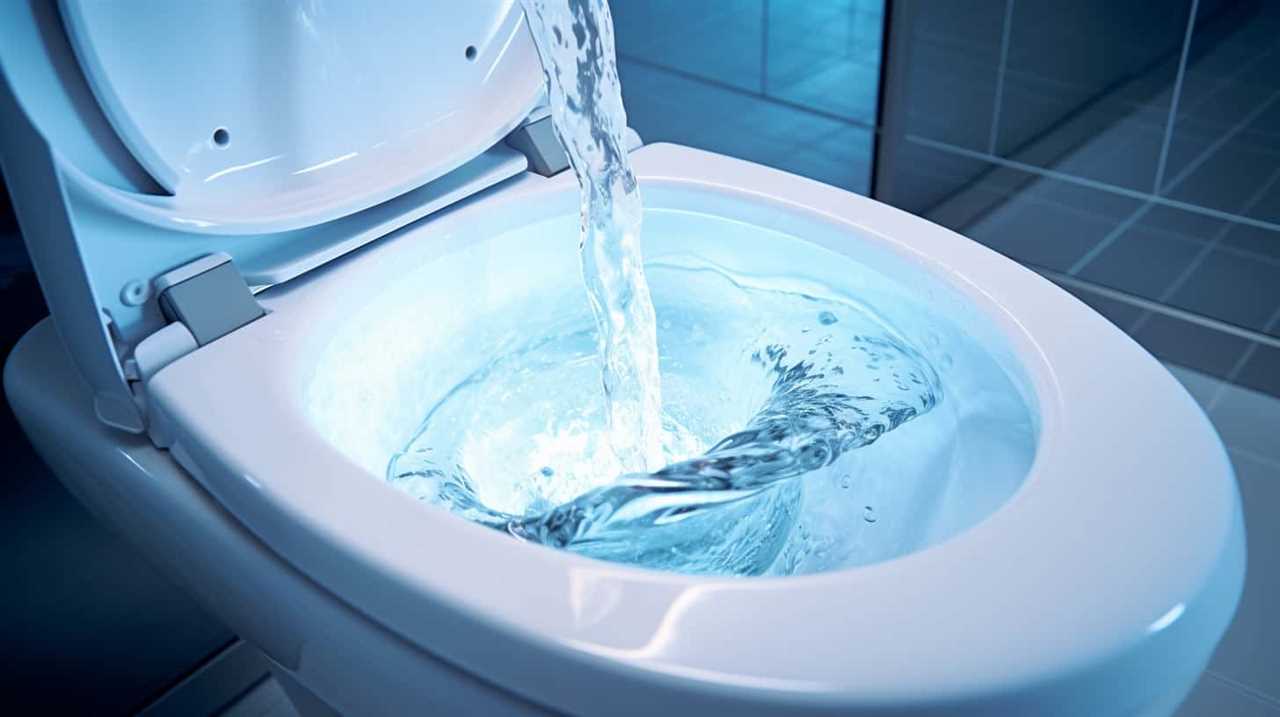
With a clean sensor, you can expect a reliable and efficient flushing experience. However, if you encounter any issues despite maintaining a clean sensor, it may be necessary to troubleshoot common sensor issues. Let’s now explore some common problems that may arise and the steps to resolve them.
Troubleshooting Common Sensor Issues
When it comes to touchless toilets, one common issue that users may encounter is the sensor not detecting correctly, resulting in the toilet not flushing. This can be frustrating, as it defeats the purpose of a touchless system.
In order to troubleshoot this problem, it’s important to understand the possible causes and solutions for a malfunctioning sensor.
Sensor Not Detecting Correctly
We often encounter issues with the sensor not picking up movement accurately, which can prevent the touchless toilet from flushing properly. To address this problem, here are three troubleshooting techniques you can try:
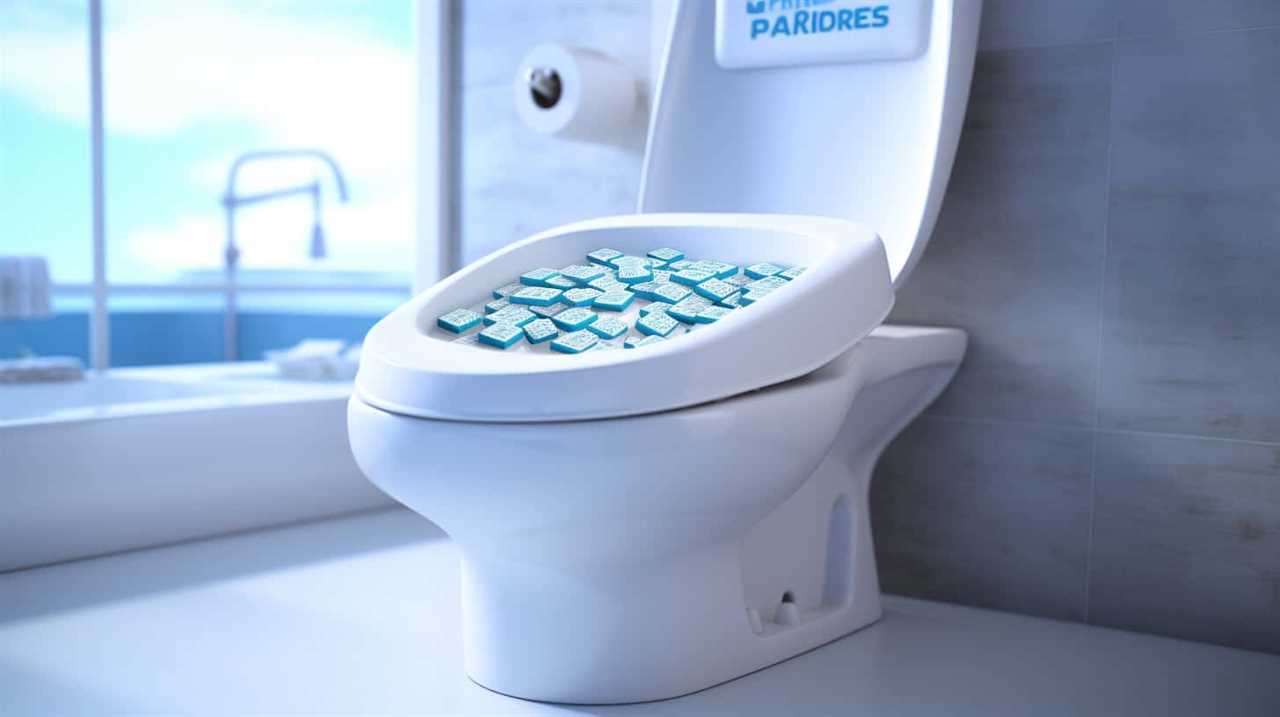
- Check for sensor calibration: Ensure that the sensor is properly calibrated by referring to the manufacturer’s instructions. Calibration may involve adjusting the sensor sensitivity or range to optimize its performance.
- Clean the sensor area: Dust, dirt, or other debris on the sensor can interfere with its detection capabilities. Gently clean the sensor and the surrounding area using a soft cloth or a mild cleaning solution. Avoid using abrasive materials that could damage the sensor.
- Remove any obstructions: Objects or obstacles near the sensor can obstruct its view and prevent accurate detection. Make sure there are no items blocking the sensor’s line of sight. Clear any potential obstructions to allow the sensor to function correctly.
Toilet Not Flushing
To address the issue of a touchless toilet not flushing properly, let’s troubleshoot common sensor issues that may be causing the problem.
When a touchless toilet fails to flush, it could be due to a few common problems with the sensor. First, check if the sensor is obstructed by any dirt or debris. Clean it gently with a soft cloth to ensure it can detect motion accurately.
Another possible issue is low battery power. Replace the batteries if they’re running low.
Additionally, ensure that the sensor is properly aligned with the flushing mechanism. If it’s misaligned, adjust it to ensure proper operation.
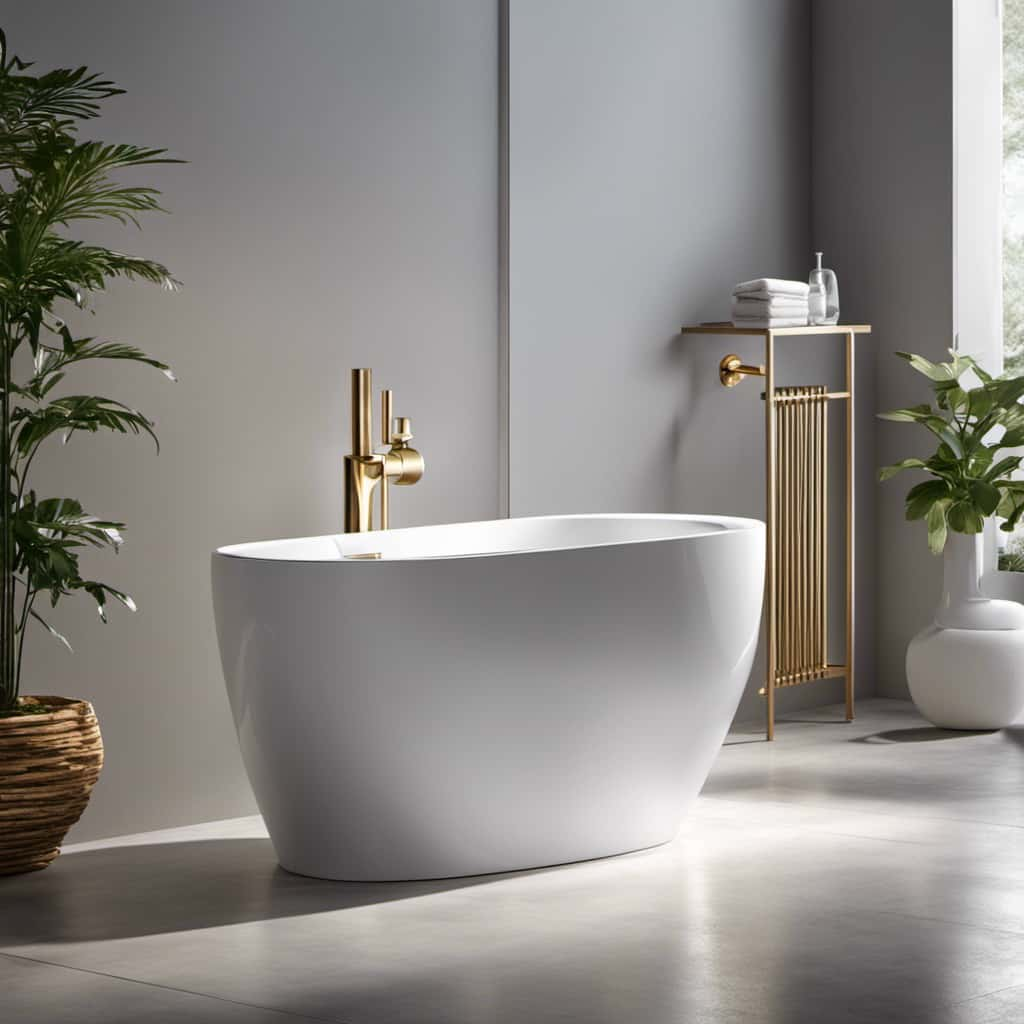
Using Manual Override Options
Occasionally, we may need to utilize the manual override options to flush a touchless toilet. These features are designed to help us overcome any issues that may arise with the automated flushing mechanism.
Here are some troubleshooting tips to help you effectively use the manual override options:
- Locate the manual override button or lever: Different touchless toilets have different manual override features. It could be a small button located near the flush sensor or a lever on the side of the toilet. Familiarize yourself with the specific location of the manual override feature on your toilet.
- Press or pull the manual override: Once you have located the manual override button or lever, press or pull it firmly to activate the flushing mechanism. Be sure to apply enough pressure to ensure a successful flush.
- Repeat if necessary: In some cases, a single press or pull of the manual override may not be enough to flush the toilet completely. If this happens, repeat the action until the toilet flushes completely.
Maintaining a Touchless Toilet
When it comes to maintaining a touchless toilet, there are a few key points to keep in mind.
Firstly, regular cleaning of the touchless sensors is crucial to ensure proper functioning.

Additionally, it’s important to take steps to prevent water leaks, such as checking for loose connections and ensuring the toilet is properly sealed.
Lastly, being aware of common issues and troubleshooting them promptly can help to avoid any major problems.
Cleaning Touchless Sensors
We regularly clean the touchless sensors to maintain the functionality of our touchless toilet. Cleaning the sensors is essential to ensure accurate detection and reliable flushing. Here are three important steps to follow for cleaning touchless sensors:
- Gently wipe the sensors with a soft, lint-free cloth: Use a non-abrasive cloth to wipe away any dirt, dust, or fingerprints that may have accumulated on the sensors. Avoid using harsh chemicals or abrasive materials, as they can damage the sensors.
- Use a mild cleaning solution: In case the sensors are heavily soiled, you can use a mild cleaning solution specifically designed for touchless sensors. Ensure that the solution is compatible with the sensor’s material and follow the manufacturer’s instructions for proper usage.
- Regularly inspect and troubleshoot sensor issues: Check the sensors regularly for any signs of damage or malfunction. If the sensors aren’t working properly, try replacing the batteries or contacting the manufacturer for further assistance.
By regularly cleaning and maintaining the touchless sensors, you can ensure optimal performance and prevent sensor-related issues.
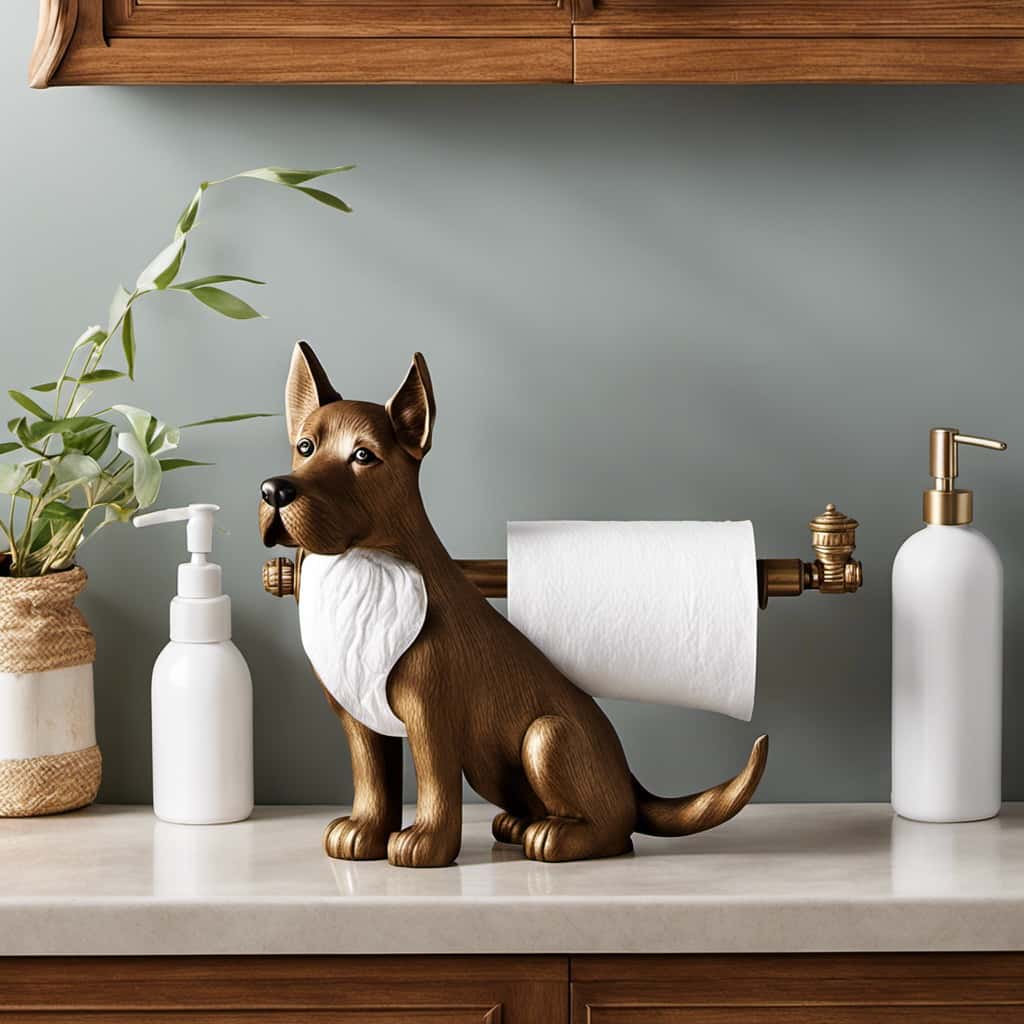
Now, let’s move on to the next section about preventing water leaks.
Preventing Water Leaks
To maintain a touchless toilet and prevent water leaks, regular inspection and maintenance of the flush valve is crucial. The flush valve is responsible for regulating the water flow and ensuring a proper flush. Over time, debris and mineral buildup can affect the valve’s performance, leading to leaks.
To prevent water leaks, it’s important to troubleshoot common issues. Firstly, check for any visible signs of water leakage around the toilet base or on the floor. If present, it could indicate a faulty seal or loose connections.
Secondly, listen for any hissing or running water sounds, which may suggest a leaky flapper valve.
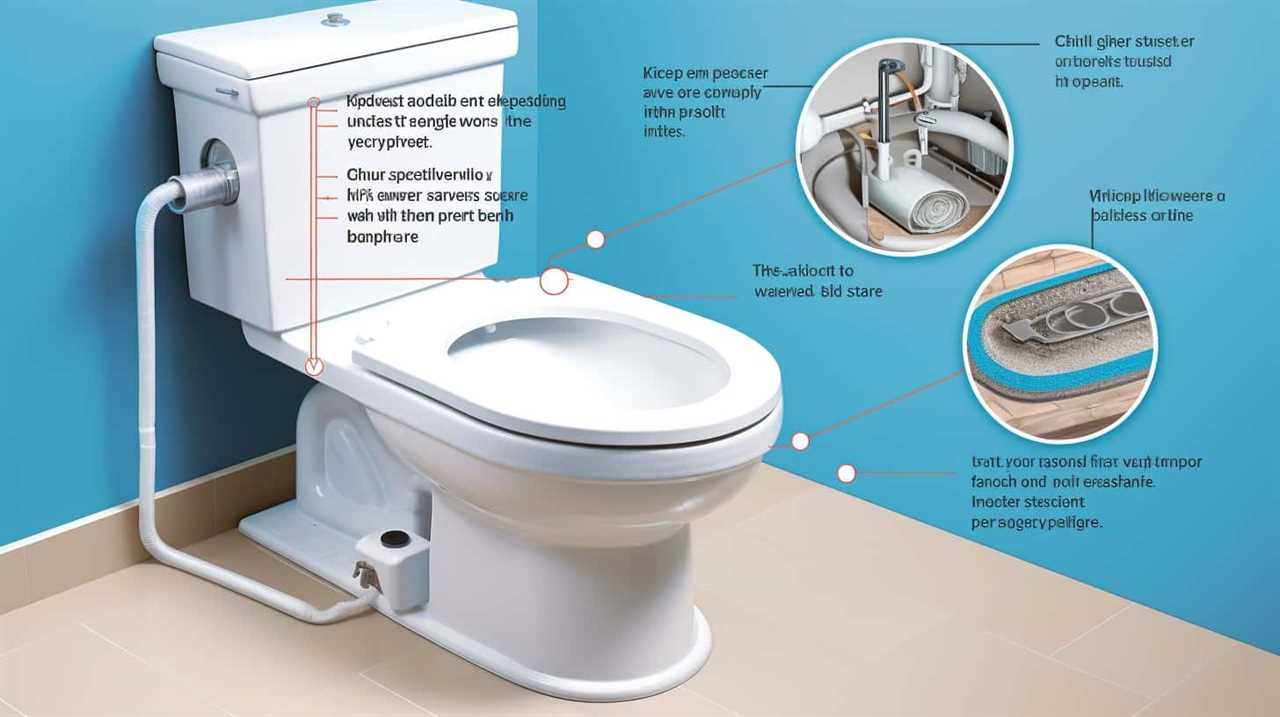
Lastly, inspect the water supply line for any cracks or damage. By addressing these issues promptly, you can prevent water leaks and maintain the efficiency of your touchless toilet.
Troubleshooting Common Issues
To ensure the proper functioning of our touchless toilet, regular maintenance and troubleshooting are essential. Here are three common issues that may arise with touchless toilets and how to troubleshoot them:
- Troubleshooting Sensor Calibration: If the touchless toilet isn’t flushing consistently or is flushing when no one is present, the sensor calibration may be off. To troubleshoot, try cleaning the sensor with a soft cloth and mild soap. If that doesn’t work, consult the manufacturer’s instructions for recalibrating the sensor.
- Troubleshooting Flush Delay: If there’s a delay between when the sensor is activated and when the toilet flushes, there may be an issue with the flush delay settings. Check the user manual for instructions on adjusting the flush delay. If the problem persists, contact a professional plumber for further assistance.
- Additional Troubleshooting: If the touchless toilet is still not functioning properly after troubleshooting the sensor calibration and flush delay, there may be a more complex issue at hand. In this case, it’s recommended to contact a qualified plumber or the manufacturer’s customer service for assistance.
Cleaning and Disinfecting the Flush Sensor
To properly clean and disinfect the flush sensor of a touchless toilet, it’s important to follow a few simple steps using the appropriate cleaning solution. The flush sensor, which detects motion and triggers the flush, can accumulate dirt and germs over time. To maintain optimal hygiene and functionality, it’s recommended to clean the flush sensor regularly.
The cleaning frequency for the flush sensor depends on the usage and environment. In high-traffic areas, it may be necessary to clean the sensor more frequently to prevent buildup. A general guideline is to clean the flush sensor at least once a week to ensure its proper functioning.
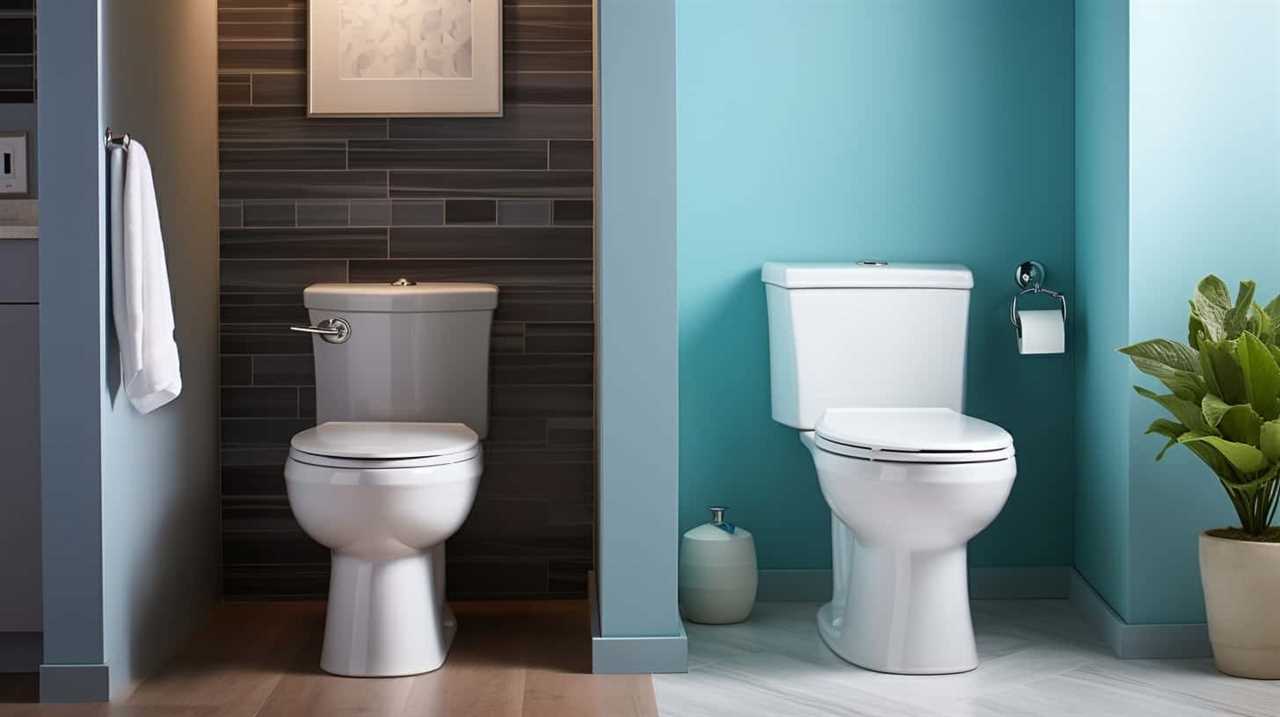
When it comes to choosing the cleaning products, it’s crucial to use solutions that are safe for the sensor and effective in removing dirt and germs. Avoid using abrasive cleaners or those containing bleach, as they can damage the sensor. Instead, opt for mild, non-abrasive cleaners specifically designed for touchless toilets. These cleaners are formulated to effectively clean and disinfect the sensor without causing any harm.
To clean the flush sensor, start by turning off the power source to avoid accidental activation. Then, apply the cleaning solution to a soft cloth or sponge and gently wipe the sensor surface, taking care not to press too hard. Finally, rinse the sensor with clean water and dry it thoroughly.
Benefits of Touchless Flushing
Using touchless flushing in our bathrooms offers numerous advantages. Here are three reasons why touchless toilets are a game-changer:
- Improved hygiene: Touchless flushing technology eliminates the need to physically touch the toilet flush handle, reducing the spread of germs and bacteria. This is particularly beneficial in public restrooms where many people come into contact with the same surfaces. By simply waving a hand in front of the sensor, the toilet flushes automatically, ensuring a more sanitary experience.
- Convenience and ease of use: With touchless toilets, there’s no need to struggle with a handle or button. The convenience of touchless flushing allows for a seamless and effortless experience. Whether you have limited mobility or simply want to avoid touching potentially dirty surfaces, touchless flushing technology provides an efficient and user-friendly solution.
- Water conservation: Touchless toilets are designed to be water-efficient. The sensors detect when someone is using the toilet and adjust the water flow accordingly, minimizing unnecessary water usage. This not only helps to preserve water resources but also reduces water bills, making touchless toilets an environmentally friendly and cost-effective choice.
By embracing touchless flushing technology, we can enjoy improved hygiene, convenience, and water conservation in our bathrooms.
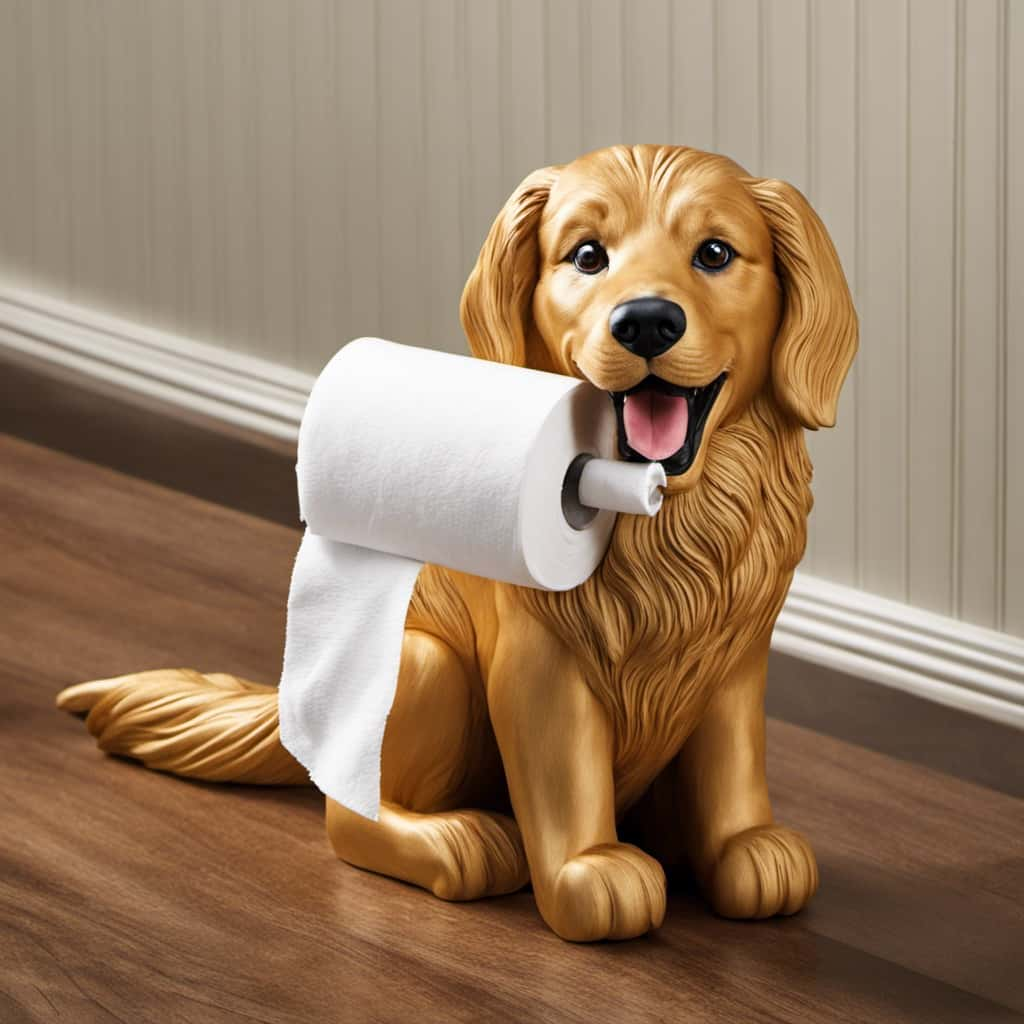
Now, let’s dive into comparing touchless toilets to traditional toilets and explore the differences between these two flushing options.
Comparing Touchless Toilets to Traditional Toilets
Touchless toilets offer several advantages over traditional toilets, making them a superior choice for modern bathrooms. When comparing touchless toilets to traditional toilets, there are a few key differences that set them apart.
One major advantage of touchless toilets is the hygienic benefits they provide, especially in public restrooms. Traditional toilets require users to touch the flush handle, which can harbor germs and spread bacteria. In contrast, touchless toilets use sensor technology to automatically flush, eliminating the need for physical contact and reducing the risk of cross-contamination.
Another benefit of touchless toilets is their water-saving capabilities. Traditional toilets typically use a set amount of water per flush, regardless of the waste volume. Touchless toilets, on the other hand, utilize advanced sensing technology to adjust the water flow based on the waste level, resulting in more efficient water usage and lower water bills.

To further illustrate the differences between touchless toilets and traditional toilets, here is a table highlighting some key features:
| Feature | Touchless Toilets | Traditional Toilets |
|---|---|---|
| Hygiene | No touch required | Touch flush handle |
| Water Efficiency | Adjustable flow | Fixed flow |
| Maintenance | Less prone to clogs | May clog more easily |
| Ease of Use | Automatic flushing | Manual flushing |
| Cost | Higher upfront cost | Lower upfront cost |
Installing a Touchless Toilet in Your Bathroom
When installing a touchless toilet in our bathroom, we need to consider a few important factors:
- Location: Choose a suitable location for the touchless toilet that allows for easy access and functionality. Consider the proximity to the water supply and drain lines to ensure efficient installation.
- Plumbing Requirements: Installing touchless faucets may require modifications to the existing plumbing system. It’s essential to consult a professional plumber to ensure proper installation. They can assess the water pressure, supply lines, and drainage requirements.
- Benefits of Touchless Technology: Touchless toilets offer several advantages, including improved hygiene, convenience, and water efficiency. The hands-free operation minimizes the spread of germs and reduces cross-contamination. Additionally, touchless technology often includes features such as adjustable flush settings and water-saving options, contributing to a more sustainable bathroom.
Frequently Asked Questions About Touchless Toilets
Now let’s address some common queries about touchless toilets.
One frequently asked question is how to troubleshoot touchless toilets. If your touchless toilet isn’t flushing properly, there are a few troubleshooting steps you can take. First, check the batteries in the sensor. Low batteries can cause the sensor to malfunction. Replace the batteries if necessary. Next, ensure that the sensor is clean and free from any obstructions. Dust or debris on the sensor can interfere with its functioning. Clean the sensor with a soft cloth or a mild cleaning solution. If these steps don’t resolve the issue, it might be necessary to call a professional plumber to inspect and repair the touchless toilet.
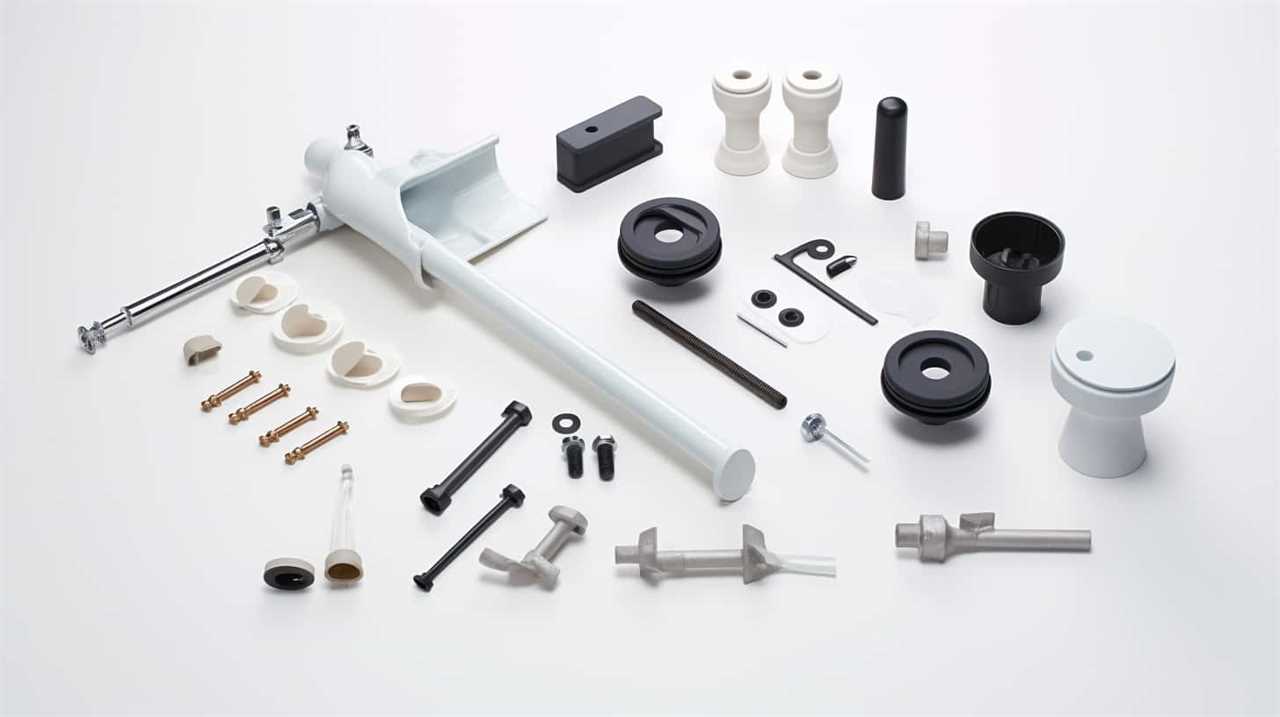
Another common query is about the benefits of touchless technology in toilets. Touchless toilets offer several advantages. Firstly, they eliminate the need for physical contact, reducing the spread of germs and promoting better hygiene. Secondly, touchless toilets are more convenient and user-friendly, especially for children or individuals with limited mobility. They often feature automatic flush mechanisms and sensor-operated lids. Additionally, touchless toilets save water by using efficient flushing mechanisms and offering dual-flush options. This not only helps the environment but also reduces water bills. Overall, touchless toilets provide a hygienic, convenient, and water-saving solution for modern bathrooms.
Frequently Asked Questions
Can I Use a Touchless Toilet if I Have Mobility Issues or Limited Hand Dexterity?
When considering touchless toilet technology, it’s important to consider the benefits for individuals with mobility issues or limited hand dexterity. Using a touchless toilet eliminates the need for physical contact, making it accessible for those who may struggle with traditional flushing mechanisms.
This advanced technology utilizes sensors to detect movement, allowing for a hygienic and convenient flushing experience. By incorporating touchless toilets, individuals with disabilities can enjoy increased independence and ease of use in the bathroom.
How Do Touchless Toilets Help in Preventing the Spread of Germs and Bacteria?
Touchless toilets play a crucial role in preventing the spread of germs and bacteria. By utilizing advanced touchless toilet technology, these toilets eliminate the need for physical contact, reducing the risk of contamination.
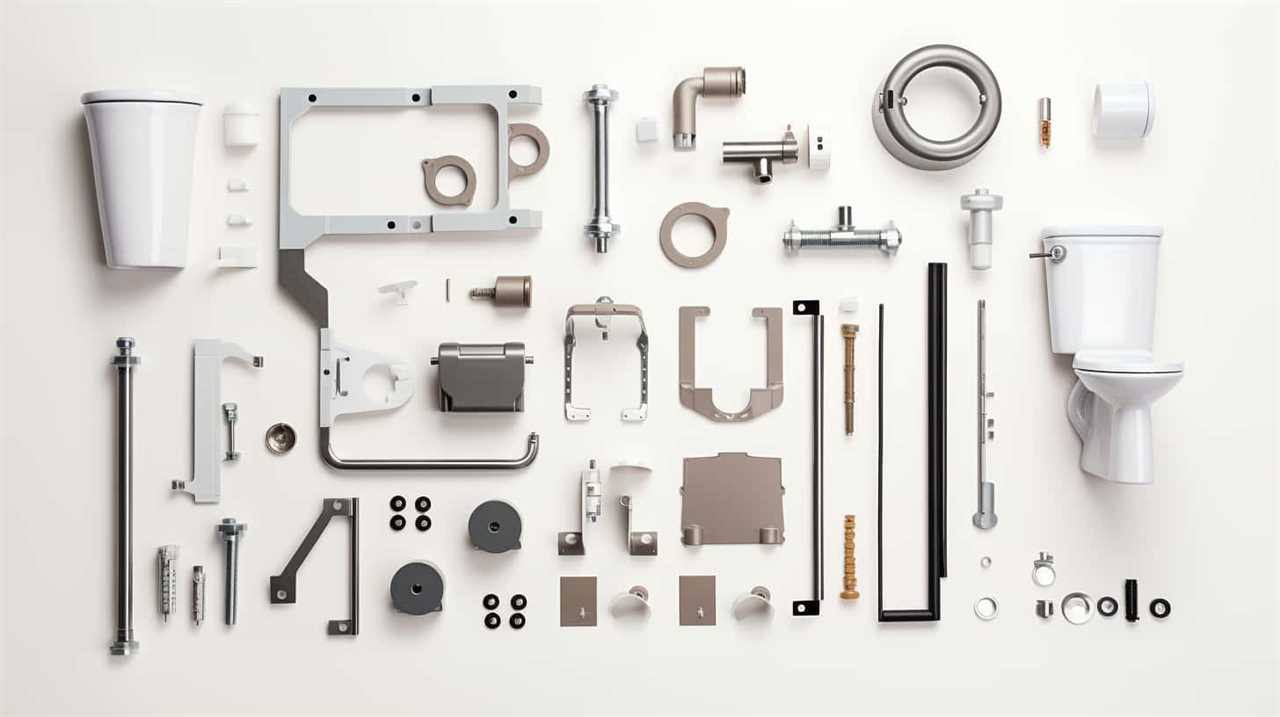
The benefits of touchless toilets extend beyond hygiene, as they also promote convenience and efficiency. With a simple wave or sensor activation, the toilet flushes automatically, ensuring a sanitary and effortless experience.
This innovative solution is particularly beneficial for individuals with mobility issues or limited hand dexterity, providing them with greater independence and improved hygiene.
Are Touchless Toilets More Expensive to Install and Maintain Compared to Traditional Toilets?
Touchless toilet technology offers convenience and helps prevent the spread of germs and bacteria.
As for cost comparison, touchless toilets may be more expensive to install due to the advanced technology involved. However, they can save money in the long run by reducing water consumption.

Maintenance costs may vary depending on the specific model and brand.
It’s important to consider these factors when deciding between a touchless toilet and a traditional one.
Can I Still Manually Flush a Touchless Toilet if the Sensor Malfunctions?
If the sensor on a touchless toilet malfunctions, it’s still possible to manually flush it. Most touchless toilets have a backup manual flush option, usually in the form of a button or lever located near the sensor.
Are Touchless Toilets Suitable for Public Restrooms With High Usage?
Touchless toilets have become increasingly popular in public restrooms due to advancements in touchless toilet technology. These toilets are suitable for high usage environments, as they help reduce the spread of germs and bacteria.

In fact, studies have shown that touchless toilets can reduce water consumption by up to 70% compared to traditional toilets. This makes them not only hygienic, but also environmentally friendly.
The benefits of touchless toilets make them a smart choice for any public restroom.
Conclusion
In conclusion, touchless toilets offer a convenient and hygienic solution for flushing. The advanced technology behind these toilets allows for a hands-free experience, reducing the spread of germs and promoting cleanliness.
By simply locating and activating the flush sensor, you can easily flush the toilet without touching any surfaces. With adjustable sensor sensitivity and numerous benefits, touchless toilets are a modern and efficient choice for any bathroom.
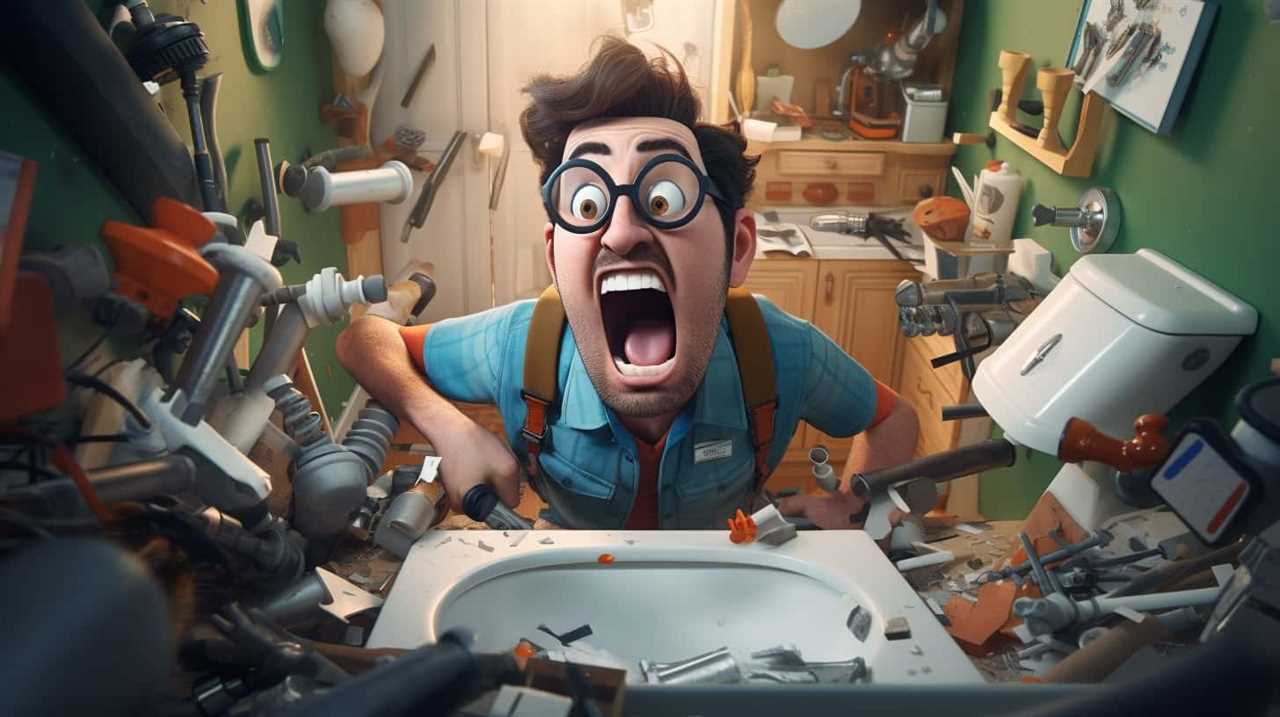
Upgrade your bathroom with a touchless toilet and experience the future of flushing.
With an impeccable eye for detail and a passion for bathroom-related, Ava leads our editorial team gracefully and precisely.
Under her guidance, Best Modern Toilet has flourished as the go-to resource for modern bathroom enthusiasts. In her free time, you might find Ava exploring antique shops and looking for vintage bathroom fixtures to add to her collection.
FAQ - Advanced Bathroom Queries
Cheapest Flushable Cat Litter

We understand your skepticism about discovering the most affordable flushable cat litter. But fret not, cat lovers! We’ve conducted thorough research and put together a detailed guide to assist you in exploring the realm of economical flushable cat litters. Dive in and uncover the secrets to finding the best deal!
From the benefits and factors to consider, to step-by-step transitioning and maintenance tips, we’ve got you covered.
Get ready to master the art of finding affordable flushable cat litter without compromising quality.
Key Takeaways
- Reduces landfill waste
- Contributes to a more sustainable future
- Offers convenience and ease of use
- Saves time and effort in cleaning the litter box
Benefits of Using Flushable Cat Litter
One of the main benefits of using flushable cat litter is that it reduces the amount of waste we’ve to dispose of. This has a significant positive environmental impact as it helps to minimize landfill waste. Traditional cat litter, which isn’t flushable, adds to the already massive amount of non-biodegradable waste in our landfills. Choosing a flushable cat litter allows us to contribute to a more sustainable future.
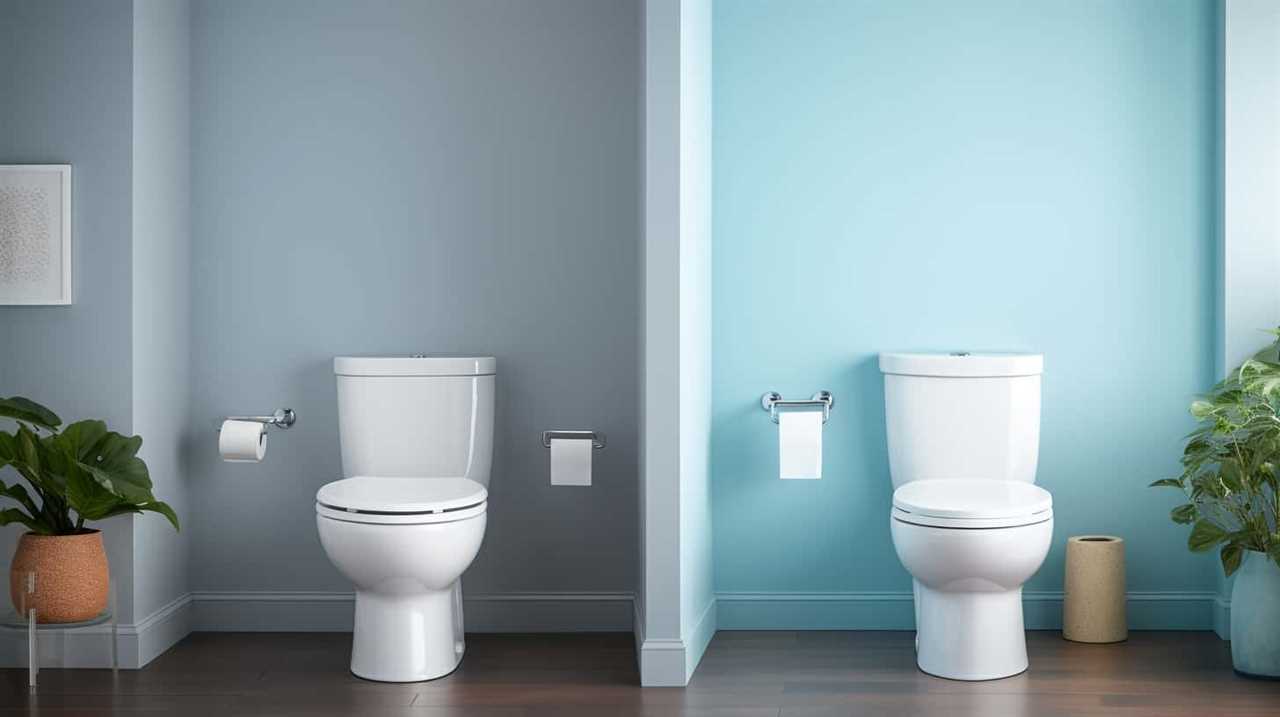
In addition to the environmental benefits, flushable cat litter also offers convenience and ease. Instead of scooping and bagging up the litter box waste, we can simply flush it down the toilet. This saves time and effort, making the process of maintaining a clean litter box much more convenient.
Considering both the environmental impact and the convenience and ease it provides, using flushable cat litter is a smart choice for cat owners. However, it’s important to consider certain factors when choosing the cheapest flushable cat litter.
Factors to Consider When Choosing the Cheapest Flushable Cat Litter
When selecting the cheapest flushable cat litter, there are several factors that we should take into consideration. Here are four key factors to keep in mind:
- Cost-effective options: Look for cat litters that offer the best value for money. Consider the price per pound or per use, as well as any discounts or bulk options available.
- Environmental impact: Opt for cat litters that are biodegradable and made from sustainable materials. This not only reduces waste but also minimizes the impact on the environment.
- Clumping ability: Choose a cat litter that forms strong clumps for easy scooping and cleaning. This ensures efficient use and reduces the frequency of litter box changes.
- Odor control: Look for cat litters that have effective odor control properties. This helps to keep your home smelling fresh and clean, even with a litter box in use.
Considering these factors will help you find the cheapest flushable cat litter that meets your budget, while also being environmentally friendly.

Now, let’s move on to a step-by-step guide on how to transition your cat to flushable litter.
Step-By-Step Guide on How to Transition Your Cat to Flushable Litter
To transition our cat to flushable litter, we found using a gradual approach to be the most effective. The transition process can be stressful for cats, so it’s important to take it slow and be patient.
Start by mixing a small amount of flushable litter with your cat’s current litter, gradually increasing the ratio over time. This allows your cat to become familiar with the new litter while still having the comfort of their old litter.
Additionally, provide alternative options for your cat, such as a separate litter box with their old litter, to ease the transition. Observe your cat’s behavior and adjust the transition pace accordingly.
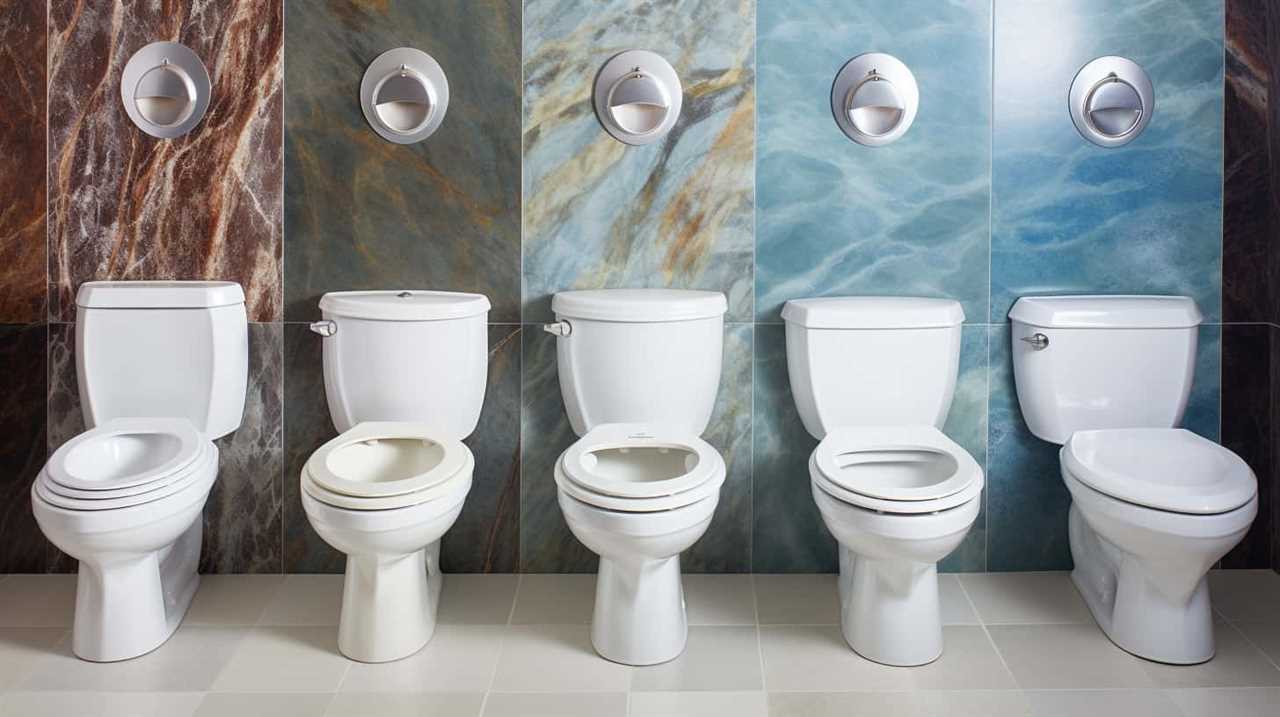
Remember to praise and reward your cat for using the flushable litter to reinforce positive associations. With time and patience, your cat will successfully transition to flushable litter.
Tips for Maintaining a Clean and Odor-Free Litter Box With Flushable Cat Litter
To maintain a clean and odor-free litter box with flushable cat litter, we recommend implementing a regular scooping routine. Here are some tips for reducing litter tracking and properly disposing of flushable cat litter:
- Place a litter mat or tray outside the litter box to catch any litter that may stick to your cat’s paws. This will help prevent it from being tracked around your home.
- Use a litter box with high sides or a covered litter box to contain any litter that may be kicked out during your cat’s digging and burying.
- Scoop the litter box at least once a day to remove any waste and clumps. This will help prevent odor buildup and keep the litter box clean for your cat.
- When disposing of flushable cat litter, make sure to follow the manufacturer’s instructions. Some brands can be safely flushed down the toilet, while others may require bagging and disposing of in the trash.
By following these tips, you can maintain a clean and odor-free litter box with flushable cat litter.
Now, let’s move on to the next section where we’ll provide reviews and recommendations for the top affordable flushable cat litters.
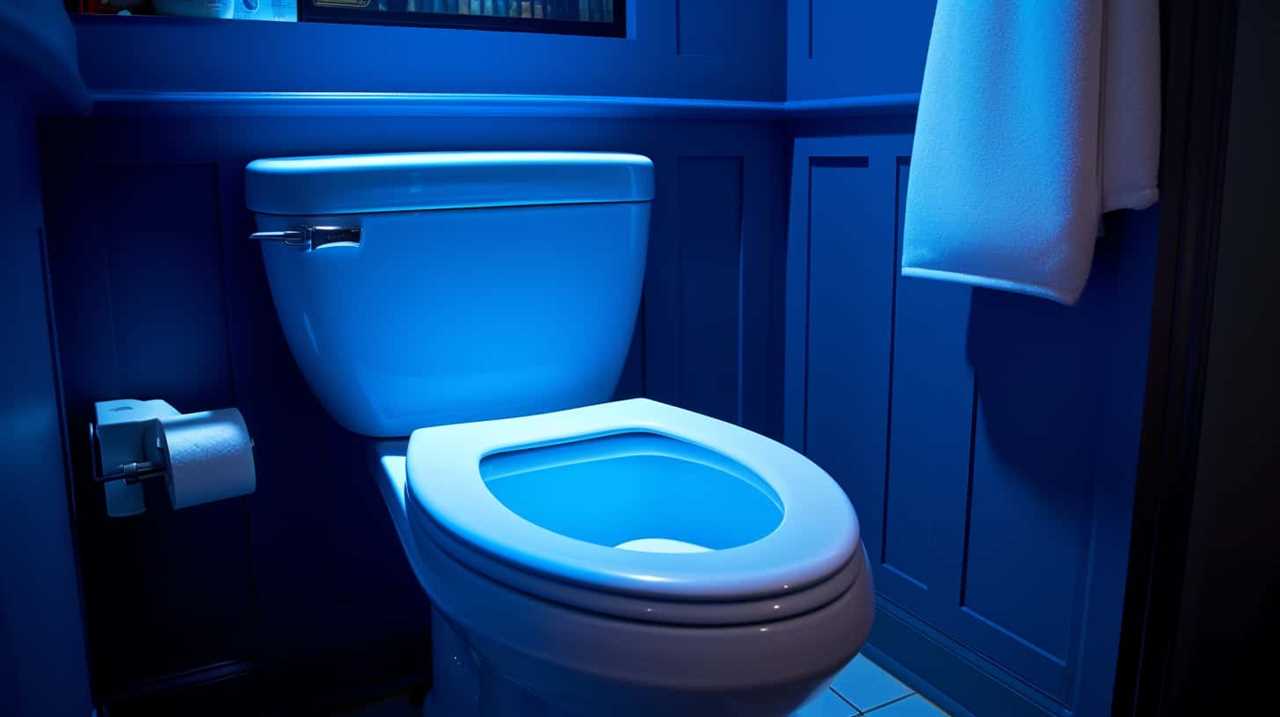
Reviews and Recommendations for the Top Affordable Flushable Cat Litters
Now, let’s dive into our reviews and recommendations for the top affordable flushable cat litters.
When considering flushable cat litters, it’s important to evaluate their environmental impact. The advantage of flushable cat litter lies in its ability to be safely disposed of through the toilet, reducing waste in landfills. However, it’s crucial to choose a litter made from biodegradable materials to ensure minimal impact on the environment.
Additionally, when comparing the cost effectiveness of flushable cat litter with traditional options, it’s essential to consider factors such as lifespan and frequency of litter changes. While flushable cat litter may initially seem more expensive, it can be cost-effective in the long run due to its longer lifespan and reduced waste management costs.
Frequently Asked Questions
Can Flushable Cat Litter Be Used in All Types of Litter Boxes?
Yes, flushable cat litter can be used in all types of litter boxes. However, it is important to consider the pros and cons of using flushable cat litter alternatives before making a decision.
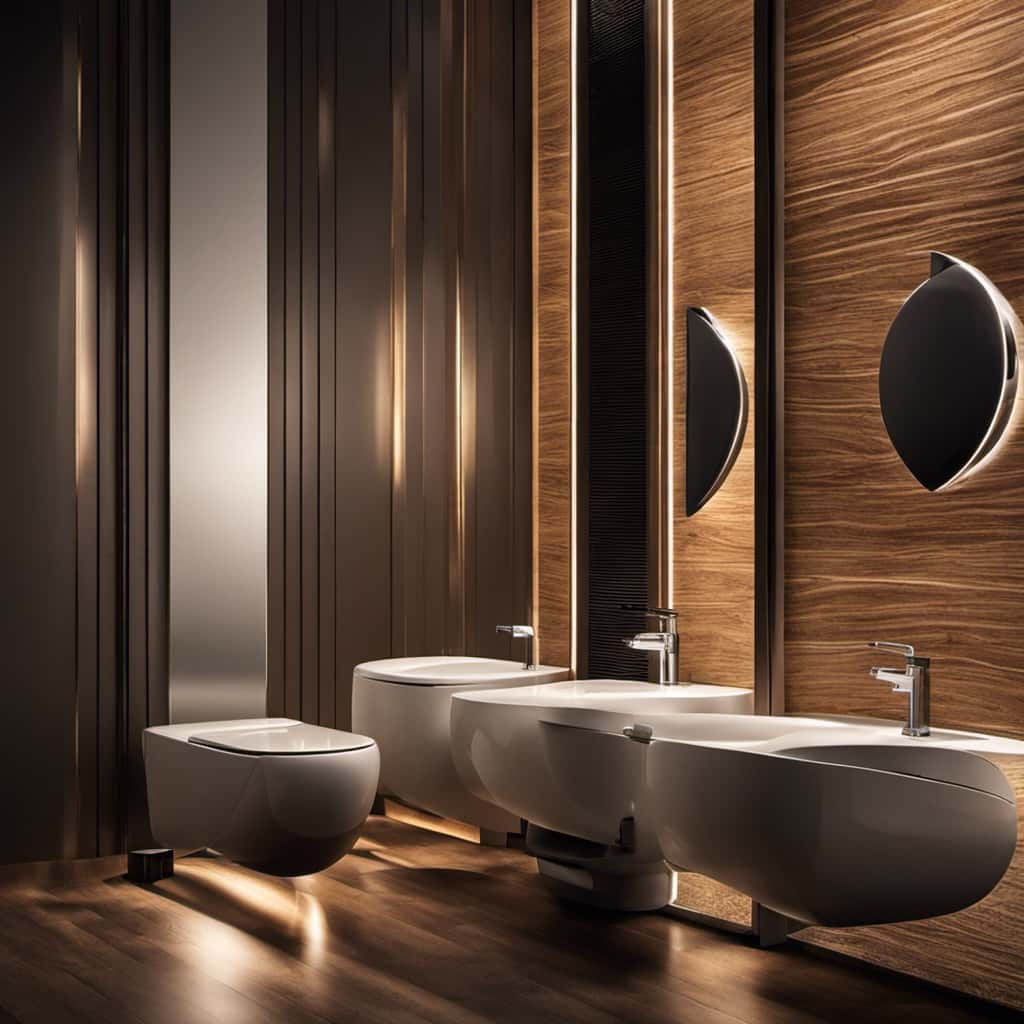
Is Flushable Cat Litter Safe for Septic Systems?
Flushable cat litter may be convenient, but is it safe for septic systems? While it is touted as eco-friendly, the pros and cons should be considered. Is flushable cat litter safe for the environment?
How Often Should I Flush the Litter When Using Flushable Cat Litter?
When using flushable cat litter, we flush it every time our cat uses the litter box. This ensures cleanliness and prevents odors. However, there are alternatives to flushable cat litter that may be more cost-effective.
Can I Mix Flushable Cat Litter With Regular Cat Litter?
When considering mixing cat litter, it’s important to note that flushable and regular litter have different compositions and functionalities. It’s best to avoid mixing them to maintain the effectiveness of flushable litter and explore alternatives to flushable litter instead.
Are There Any Specific Brands of Flushable Cat Litter That Are More Environmentally Friendly?
There are alternative eco-friendly options available when it comes to flushable cat litter. Using flushable litter has several benefits, such as reducing waste and being more environmentally friendly compared to traditional cat litter.
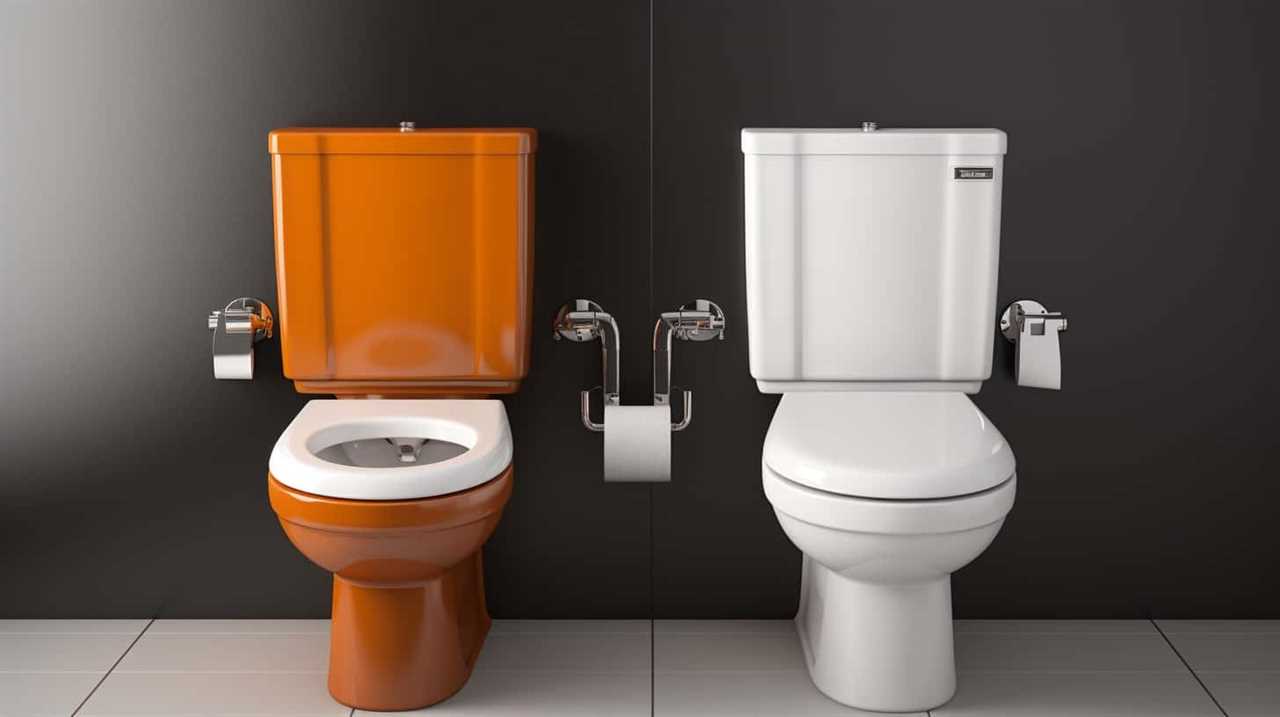
Conclusion
In conclusion, finding the cheapest flushable cat litter can be a game-changer for both you and your feline friend. By considering factors such as cost, effectiveness, and environmental impact, you can make an informed decision.
Transitioning your cat to flushable litter may require patience, but it’s worth it in the long run. With proper maintenance, you can keep your litter box clean and odor-free.
So why not give it a try and experience the convenience and efficiency of flushable cat litter? It’s like finding a hidden treasure for both you and your cat!
With an impeccable eye for detail and a passion for bathroom-related, Ava leads our editorial team gracefully and precisely.
Under her guidance, Best Modern Toilet has flourished as the go-to resource for modern bathroom enthusiasts. In her free time, you might find Ava exploring antique shops and looking for vintage bathroom fixtures to add to her collection.
FAQ - Advanced Bathroom Queries
Can You Force Flush a Toilet
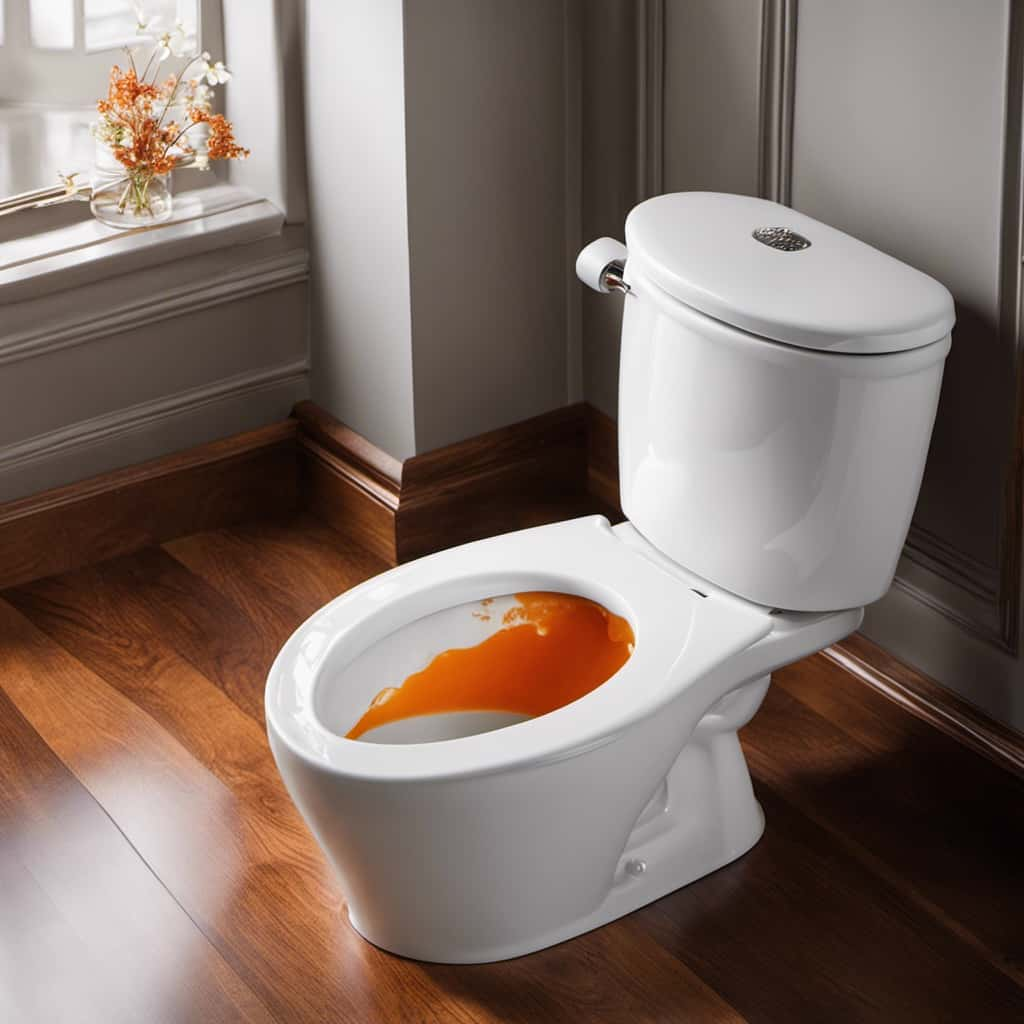
Yes, you can unleash the power of a force flush on your toilet! Have you ever thought about it before? We’re here to let you know that it is possible!
In this article, we will delve into the mechanics of a toilet flush and explain when a force flush is necessary.
We’ll also provide you with a step-by-step guide and tips for a successful force flush.
So, buckle up and get ready to master the art of force flushing your toilet!
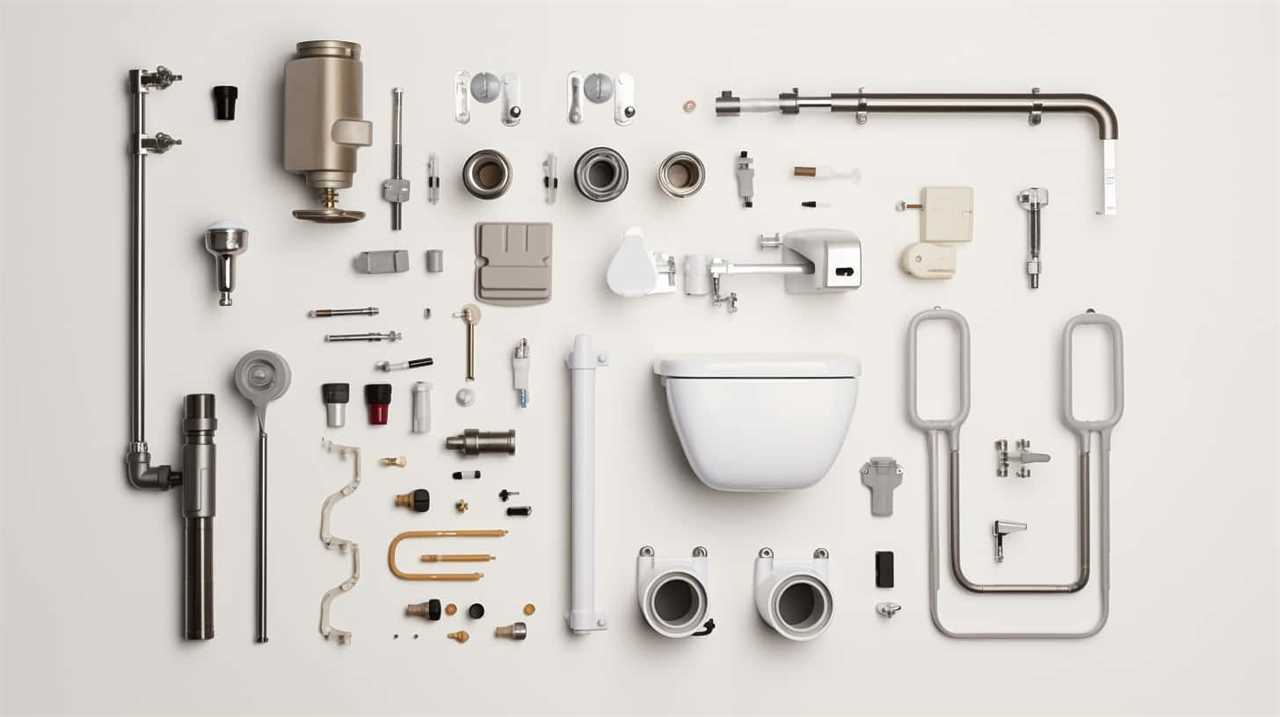
Key Takeaways
- The flush lever lifts the flapper, allowing water to rush into the bowl.
- Troubleshooting weak flushes, inconsistent water levels, or clogs involves checking the water supply, flush valve, and tank components.
- If conventional methods fail to unclog a toilet, calling a professional plumber may be necessary.
- Tools and equipment for force flushing a toilet include a plunger, high-pressure water source, rubber gloves, towels, and a bucket or pail.
Understanding the Mechanics of a Toilet Flush
To understand the mechanics of a toilet flush, we’ll delve into the workings of its water flow and pressure.
The toilet flush mechanism is a complex system that relies on the proper functioning of several components. When the flush lever is pressed, it lifts the flapper, allowing water from the tank to rush into the bowl. This creates a strong force that pushes waste down the drain.
However, if you’re experiencing issues with your toilet flush, troubleshooting the problem can be a bit challenging. Common issues include weak flushes, inconsistent water levels, or clogs.
It’s important to check the water supply, the flush valve, and the tank components for any signs of damage or malfunction. By understanding the inner workings of the toilet flush mechanism, you can effectively troubleshoot and fix any issues that arise.

Identifying When a Force Flush Is Necessary
When identifying the instances in which a force flush is necessary, we must consider the factors that may contribute to a weak or ineffective flush. Signs of a clogged toilet include water that rises to the rim or drains slowly, gurgling sounds, or a foul odor. If these signs persist despite attempts to unclog the toilet using a plunger or other methods, it may be time to call a professional plumber.
A professional plumber has the expertise and tools to effectively diagnose and resolve complex clogs that can’t be cleared through conventional means. Knowing when to call a professional plumber can prevent further damage to your plumbing system and ensure a proper force flush is performed if necessary.
With an understanding of when a force flush is needed, let’s now explore the tools and equipment required for this process.
Tools and Equipment for Force Flushing a Toilet
We will need specific tools and equipment to successfully force flush a toilet. Here are the essential items you’ll need:
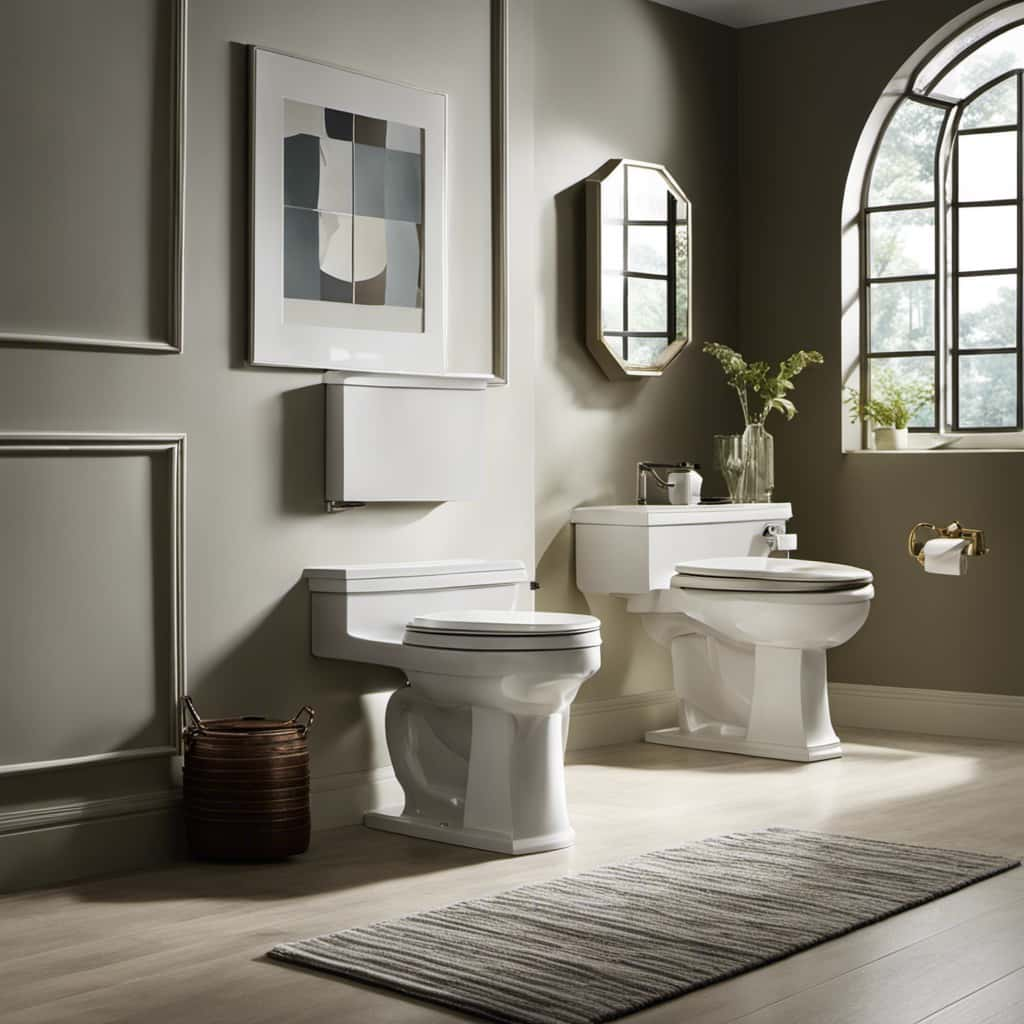
- Plunger: A plunger is a basic tool used to create pressure and force water through the drain. Choose a plunger with a flange or extension at the bottom for better seal and suction.
- High-pressure water source: To generate a forceful flush, you’ll need a high-pressure water source. This can be a handheld bidet sprayer, a pressure washer, or even a garden hose with a nozzle attachment.
- Rubber gloves: Protect your hands from any potential mess or bacteria by wearing rubber gloves. This will also provide a better grip on the plunger.
- Towels: Keep towels handy to clean up any spills or splashes that may occur during the force flushing process.
- Bucket or pail: Have a bucket or pail nearby to collect any excess water that may overflow during the force flushing.
Step-by-Step Guide to Force Flushing a Toilet
To successfully force flush a toilet, we will need to follow a step-by-step guide. Below is a table that outlines the process, along with some alternative methods for unclogging toilets.
| Step | Action |
|---|---|
| 1 | Put on protective gloves and eyewear. |
| 2 | Check for common toilet problems like a clogged trap or blocked vent pipe. |
| 3 | If the toilet is not clogged, try a plunger to force water down the drain. |
| 4 | If the plunger doesn’t work, try using a toilet auger to remove the blockage. |
| 5 | If all else fails, use a force flush by pouring a bucket of water into the toilet bowl. |
By following these steps, you can effectively force flush a toilet and resolve common toilet problems. In the next section, we will discuss some tips and precautions for a successful force flush.
Now, let’s move on to the tips and precautions for a successful force flush.
Tips and Precautions for a Successful Force Flush
Now, let’s explore some essential tips and precautions to ensure a successful force flush of the toilet.
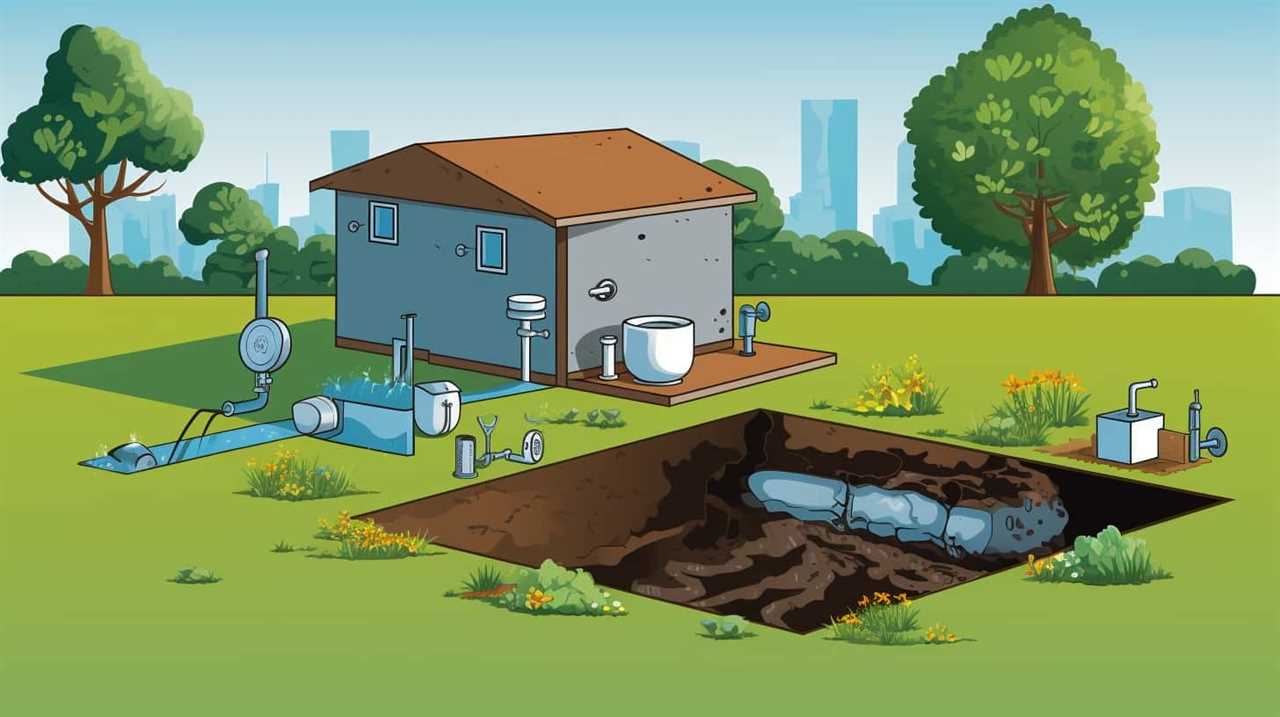
Here are some tips to prevent clogs and troubleshoot common issues:
- Use a plunger: A plunger is an effective tool for force flushing a toilet. Ensure a tight seal around the drain and use vigorous up-and-down motions to create suction and dislodge any blockage.
- Apply lubricant: If the plunger doesn’t work, try applying a small amount of lubricant, such as dish soap or petroleum jelly, around the rim of the plunger. This can improve suction and increase the chances of a successful force flush.
- Avoid excessive force: While force flushing is necessary in some cases, it’s important to avoid using excessive force as it can damage the toilet or pipes. Apply firm pressure, but be cautious.
- Check the water level: Before attempting a force flush, ensure that the water level in the toilet bowl isn’t too high. If it is, remove some water using a bucket or cup to prevent overflow.
- Call a professional: If force flushing doesn’t resolve the issue or if you encounter any other problems, it’s best to call a professional plumber. They have the expertise to handle complex toilet issues.
Frequently Asked Questions
How Long Does It Typically Take to Force Flush a Toilet?
Typically, it takes a few minutes to force flush a toilet. Common mistakes when trying to force flush include using excessive force, not checking the water level, or ignoring clogs. To troubleshoot a toilet that won’t force flush, check the water level, inspect for clogs, and ensure the flapper is functioning properly.
Can Force Flushing a Toilet Cause Any Damage to the Plumbing System?
Force flushing a toilet without proper knowledge or tools can potentially cause significant damage to the plumbing system. To prevent this, it’s crucial to understand the risks involved and take necessary precautions to ensure the integrity of the plumbing is maintained.
Is It Possible to Force Flush a Toilet Without Using Any Tools or Equipment?
Yes, you can force flush a toilet without using any tools or equipment. Some natural methods for unclogging toilets include using hot water, vinegar and baking soda, or a plunger. These DIY solutions can help resolve toilet flushing issues.
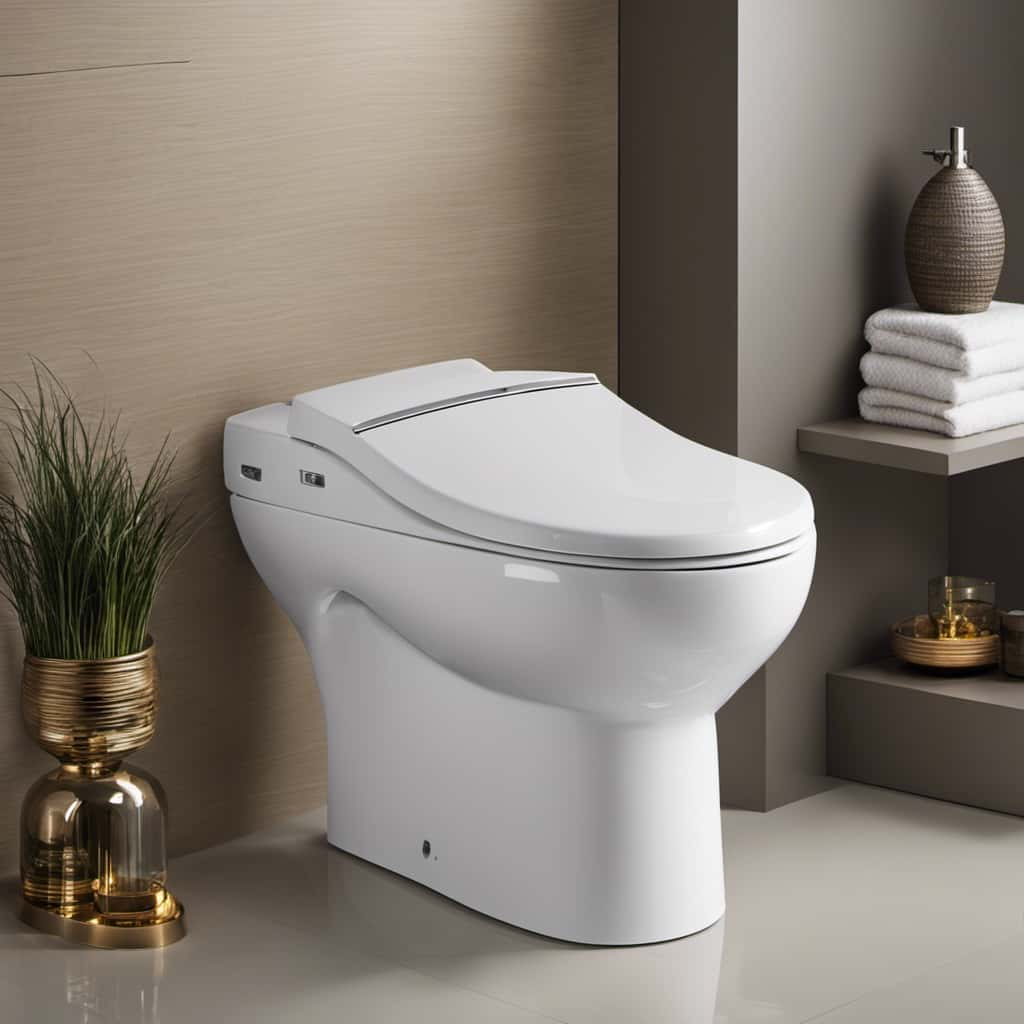
What Are Some Common Signs That Indicate a Force Flush Might Be Necessary?
Common signs that indicate a force flush might be necessary include water backing up, slow draining, and repeated clogs. To prevent clogs and avoid force flushing, proper maintenance and avoiding flushing non-flushable items are essential.
Are There Any Alternative Methods to Force Flushing a Toilet if the Recommended Tools Are Not Available?
Yes, there are alternative methods to force flush a toilet if the recommended tools are not available. DIY techniques such as pouring hot water or using a plunger can help resolve the issue.
Conclusion
In conclusion, understanding the mechanics of a toilet flush is essential for identifying when a force flush is necessary. By following a step-by-step guide and using the right tools and equipment, you can successfully force flush a toilet.
Remember to exercise caution and follow the tips provided for a smooth and efficient flush. With these techniques, you’ll be able to unclog even the most stubborn toilets with the force of a thousand storms!
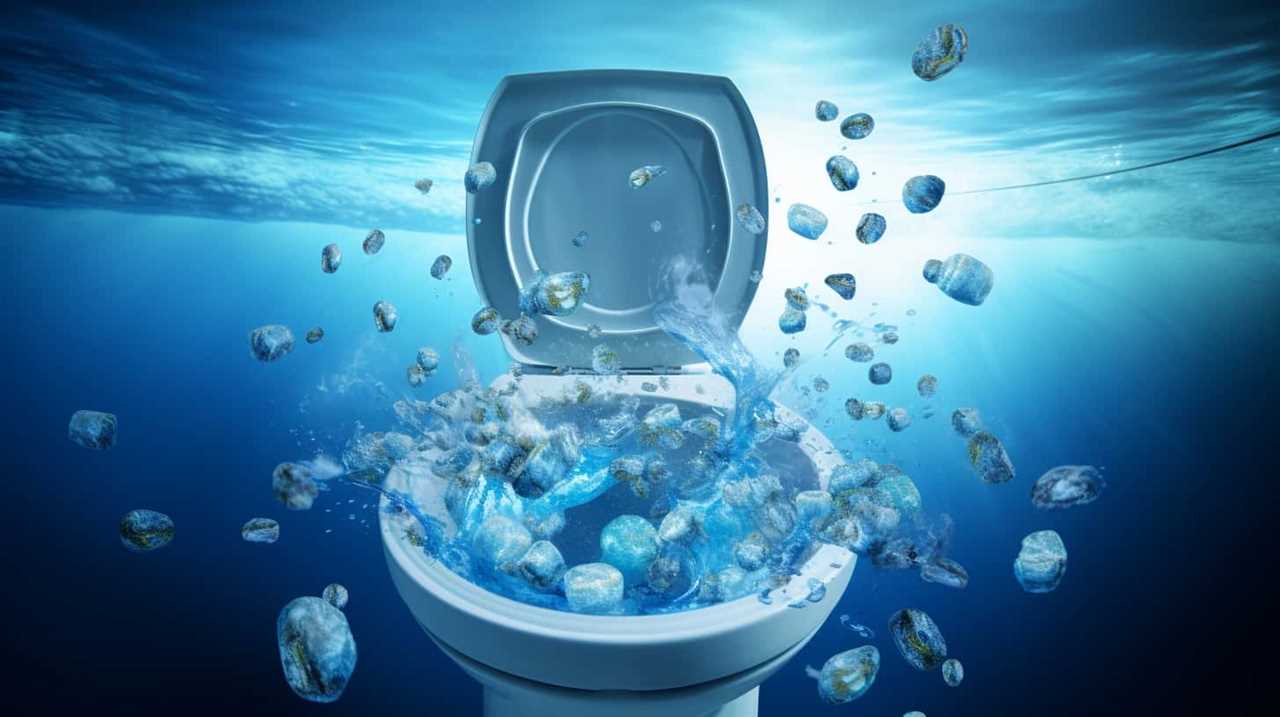
With an impeccable eye for detail and a passion for bathroom-related, Ava leads our editorial team gracefully and precisely.
Under her guidance, Best Modern Toilet has flourished as the go-to resource for modern bathroom enthusiasts. In her free time, you might find Ava exploring antique shops and looking for vintage bathroom fixtures to add to her collection.
FAQ - Advanced Bathroom Queries
Why Can’t You Flush Toilet Roll in Greece

Curious as to why toilet paper cannot be flushed in Greece? Allow us to provide some insight.
The plumbing infrastructure in Greece, although modern, is not designed to handle the disposal of toilet paper. Flushing it can lead to clogs and damage to the sewage system.
But don’t worry, we’ve got you covered. In this article, we’ll explore the reasons behind this practice, its environmental impact, and the alternatives commonly used in Greece.
Get ready to dive into the fascinating world of Greek toilet paper etiquette!
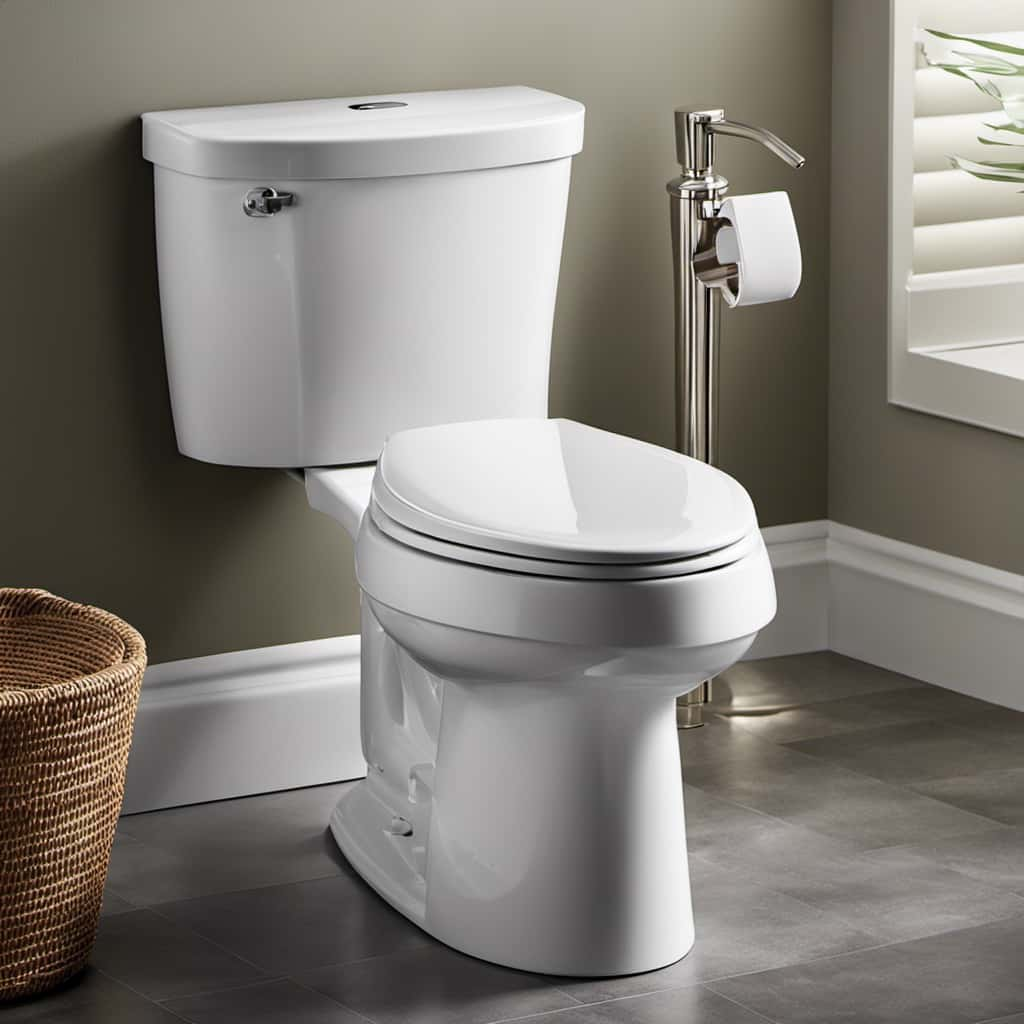
Key Takeaways
- Modern plumbing infrastructure in Greece is not designed to handle the disposal of toilet paper.
- Flushing toilet paper can lead to clogs and damage to the sewage system.
- Greece relies heavily on septic tanks, which have limited capacity to handle non-biodegradable materials like toilet paper.
- Aging infrastructure, limited capacity, and lack of maintenance contribute to the challenges in maintaining sewage systems in Greece.
Plumbing Infrastructure in Greece
Why is the plumbing infrastructure in Greece unable to handle flushing toilet paper?
Well, it all comes down to septic tank limitations and plumbing regulations.
Greece has a unique sewage system design that relies heavily on septic tanks. These tanks are designed to handle organic waste, such as human waste and toilet paper. However, they’ve limited capacity and aren’t equipped to handle large amounts of non-biodegradable materials like toilet paper.
To prevent clogging and potential damage to the system, it’s necessary to dispose of toilet paper in a separate bin provided in most restrooms. This may seem inconvenient, especially for those accustomed to simply flushing it down the toilet. However, it’s a necessary precaution to ensure the proper functioning of Greece’s plumbing infrastructure and sewage system design.
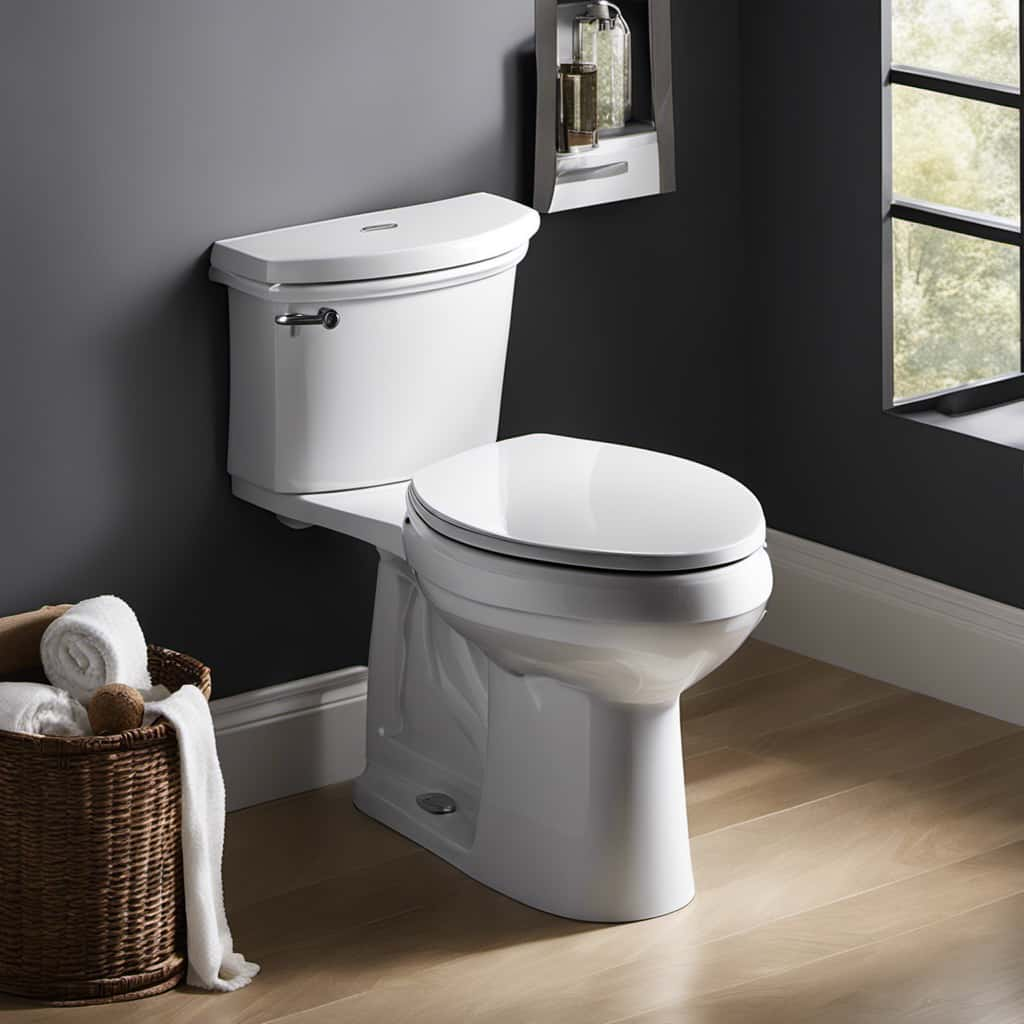
Now, let’s delve into the specifics of this unique sewage system design in Greece.
Sewage System Design in Greece
To understand the sewage system design in Greece and its limitations on flushing toilet paper, let’s delve into the unique infrastructure that relies on septic tanks and their capacity to handle non-biodegradable materials.
In Greece, municipal waste management is a significant challenge, and this extends to the sewage systems. Here are some key factors that contribute to the challenges in maintaining sewage systems in Greece:
- Aging infrastructure: Many sewage systems in Greece were built decades ago and haven’t been adequately updated or expanded to keep up with the growing population and increased waste production.
- Limited capacity: The septic tanks used in Greece have limited capacity to handle non-biodegradable materials like toilet paper, leading to frequent blockages and malfunctions.
- Lack of proper maintenance: Due to budget constraints and other priorities, the maintenance of sewage systems is often neglected, exacerbating the problems.
Understanding these challenges is crucial in comprehending the environmental impact of flushing toilet paper in Greece and finding sustainable solutions.

Environmental Impact of Flushing Toilet Paper
As we delve into the environmental impact of flushing toilet paper in Greece, it’s important to consider the consequences of disposing non-biodegradable materials into the aging sewage systems. The improper disposal of toilet paper can have detrimental effects on the environment. Flushing toilet paper contributes to paper waste management issues, as it adds to the volume of waste that needs to be treated and processed. This can put a strain on the already burdened sewage systems in Greece.
Additionally, excessive water usage from flushing toilet paper can conflict with water conservation measures that are in place to address water scarcity issues in the country. Therefore, it’s crucial to explore alternative methods of disposing of toilet paper to mitigate these environmental concerns.
Now, let’s transition into discussing the common alternatives to flushing toilet paper in Greece.
Common Alternatives to Flushing Toilet Paper in Greece
Now that we’ve explored the environmental impact of flushing toilet paper in Greece, let’s delve into the common alternatives we can use to avoid flushing it.

In Greece, bidet usage is a popular alternative to flushing toilet paper. Bidets are bathroom fixtures that spray water to clean oneself after using the toilet. They’re effective in removing waste without the need for toilet paper.
Another alternative is the use of composting toilets. These toilets are designed to convert human waste into compost that can be safely used as fertilizer. They use natural processes to break down waste, eliminating the need for flushing or traditional sewage systems.
Both bidet usage and composting toilets offer sustainable and hygienic alternatives to flushing toilet paper in Greece.
Cultural Norms and Etiquette Around Toilet Paper in Greece
In Greece, our cultural norms and etiquette dictate proper disposal methods for toilet paper. Unlike in many other countries, it isn’t common practice to flush toilet paper down the toilet. Instead, we’ve specific customs for disposing of it. This may seem strange to outsiders, but there are historical reasons behind this tradition.
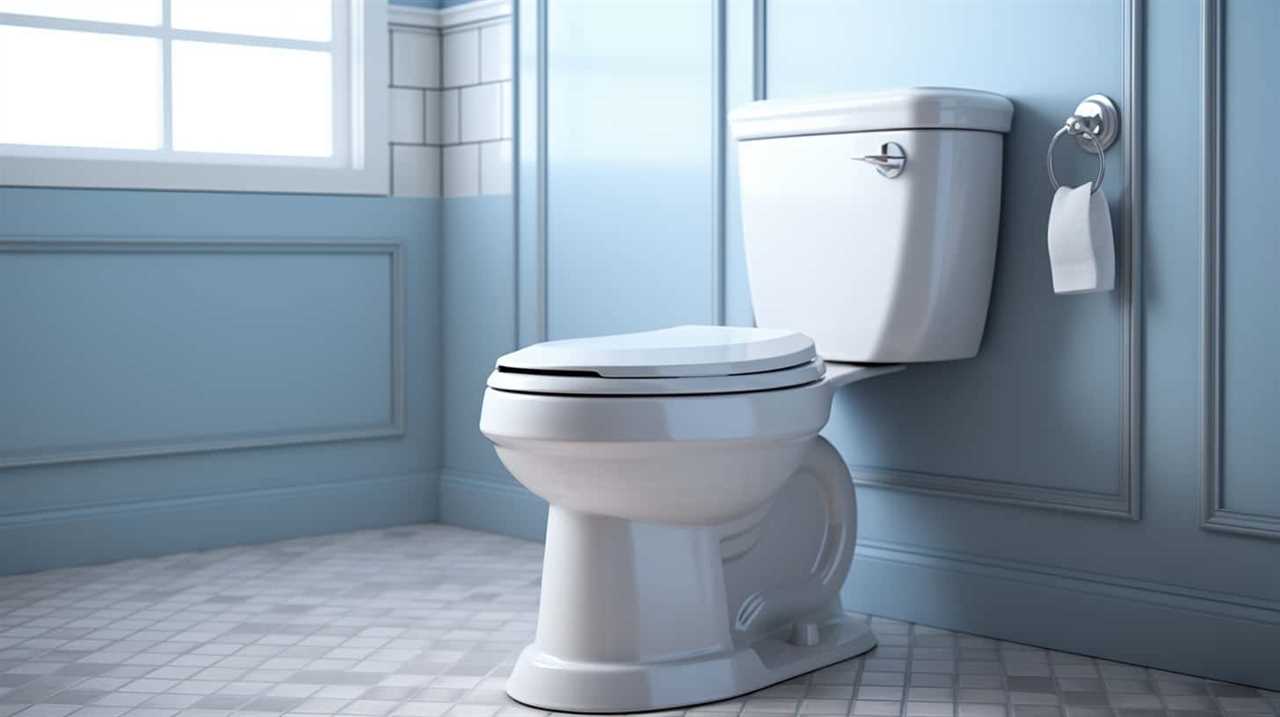
One of the main reasons for not flushing toilet paper in Greece is the age and condition of our plumbing systems. Many older buildings and houses have outdated pipes that aren’t designed to handle the flushing of toilet paper. Flushing it can lead to blockages and costly repairs.
Another reason is the concern for environmental impact. By not flushing toilet paper, we reduce the amount of waste that goes into the sewage system. This helps to protect our natural resources and minimize pollution.
Conclusion
In conclusion, when it comes to flushing toilet paper in Greece, it’s important to be mindful of the plumbing infrastructure and environmental impact. While it may not be the norm to flush toilet paper in Greece, there are alternative options available.
Understanding the cultural norms and etiquette around toilet paper can help us navigate this aspect of daily life in Greece with ease and respect. So, let’s embrace the unique customs and practices that make Greece truly special.

With an impeccable eye for detail and a passion for bathroom-related, Ava leads our editorial team gracefully and precisely.
Under her guidance, Best Modern Toilet has flourished as the go-to resource for modern bathroom enthusiasts. In her free time, you might find Ava exploring antique shops and looking for vintage bathroom fixtures to add to her collection.
-

 FAQ - Advanced Bathroom Queries3 months ago
FAQ - Advanced Bathroom Queries3 months agoWhat Happens if You Sit on the Toilet Too Long
-

 FAQ - Advanced Bathroom Queries3 months ago
FAQ - Advanced Bathroom Queries3 months agoWhy Is My Toilet so Loud When Refilling
-

 Guides3 months ago
Guides3 months agoTroubleshooting Dropping Water Level in Toilet Bowl: Causes and Solutions
-

 Guides3 months ago
Guides3 months agoToilet Water Supply Line Sizes: Finding the Right Fit
-

 Guides3 months ago
Guides3 months agoChoosing the Right Toilet Flange: A Comprehensive Guide
-

 FAQ - Advanced Bathroom Queries3 months ago
FAQ - Advanced Bathroom Queries3 months agoWhat Happens When You Put Baking Soda in Your Toilet
-

 Guides3 months ago
Guides3 months agoHow to Remove Crystallized Urine From Toilet Bowl
-

 Guides3 months ago
Guides3 months agoHow to Use Green Gobbler in Toilet





















